#had this idea of creating like a few of portraits of the roys that got taken during their childhood. SO THIS WILL BE A SERIES!! 🔥
Text

kendall and roman, ca. 1995
#had this idea of creating like a few of portraits of the roys that got taken during their childhood. SO THIS WILL BE A SERIES!! 🔥#rn also working on a logan portrait. and a shiv one (maybe with caroline mhmh)#started with kendall and roman bc i feel strongly about them. fucked up brothers 👍👍#kendall roy#roman roy#succession#fanart#my art#succession fanart
215 notes
·
View notes
Text
Okay, so I need to expand my convention stall print selection as a matter of vague urgency because my current stuff is reaching the end of its useful lifespan (the joys of a small con scene and a lot of familiar faces in the customers who've already bought all they're going to buy), so
The current mile long to-draw list for the sake of creating some accountability (bolded are the most immediate priority):
Kirk, Spock, probably also McCoy
The rest of the Trek captains from the shows I've watched (Picard, Sisko, Janeway, Archer, Pike, Burnham?? I haven't gotten far enough in Discovery for her to be captain yet but I'm assuming she is eventually)
Assorted other popular Trek characters, eventually (if you've got suggestions, Please let me know, there's 500 of these people and narrowing it down is hard)
Luke, Leia, Han
I Really can't be bothered but I know Maul, Dooku, Sidious and Vader would be popular so eventually I'm just going to have to suck it up and draw some characters I hate
Something clone troopers (I have it on good authority that there's basically no merch for clone fans)
Torchwood team (portraits, like the Doctors print I've already got)
14th and 15th Doctor (or whatever they're called) to update Doctors print
NuWho companions? At least Rose, Martha, Donna, Amy, Clara, Bill
9th Doctor, Rose and Jack group shot
Something Hot Fuzz
Something Kingsman (Eggsy and Galahad, probably)
Something Pacific Rim (currently thinking maybe three somethings? Newt & Hermann, Mako & Raleigh, Pentecost and the cancelling the apocalypse line)
Judge Dredd and Anderson from Dredd
All nine of the Fellowship of the Ring, brown paper, which is going to take forever but should be worth it because they're all popular and also I love them all, probably eventually also Eowyn and Faramir and Bilbo
The daft local in-joke Nazghul thing (there's this mounted statue of Wellington in Glasgow that always has a traffic cone on its head so I'm redrawing it as a Nazghul because I think that's funny)
Something Firefly
Roy Kent, because I've got a Ted Lasso and he's the main character people are always asking after
Something DnD movie?
And probably a dozen other things but that's enough for now
I'm trying to mainly stick to old, established fandoms and movies/series that I genuinely like that are cult-classic-y enough that they're consistently popular, because I'm fed up of how quickly The Current Popular Thing fades these days. I've done well out of drawing stuff that'll appeal to the Queer Cartoon-Watching Teens, but they're a fickle audience and getting less reliable so time to target the staple fandoms instead.
And then there's also the other list which is stuff that's mostly for my own entertainment but will probably do decently well, just not enough to be a priority right now:
A few more RWBY characters on coloured paper to expand that set (at least Penny, Nora, Ren, Jaune, Oscar)
A DCTV Flash and Reverse Flash pair of prints on red and yellow paper respectively
Something Rivers of London
An updated set of brown paper FMA art
Arcane stuff (will be higher priority when the next season is closer, but for now no one is paying it any attention)
The trio from The Marvels
Eda, Luz, King and Hooty group shot (this one should probably be on the other list, but it's down here for now because I've already got Owl House prints and right now I need to go for breadth of fandoms rather than expanding within what I've already got)
That Captain America set of four with limit colours idea that I've had for ages (Steve, Bucky, Sam, Peggy)
More brown paper Jedi (current top of the list are Aayla Secura, Shaak Ti)
A print of the main duo from The Untamed (got badges already)
Etc etc
Can you see why I never get anything done, too-many-choices choice paralysis is A Nightmare
The current plan is to start with the Star Trek stuff, because that's going to be portraits and I can do those in my sleep. If I can get Kirk and Spock done, that's a solid start. The Torchwood team print is also small portraits, so that's potentially doable as well, and a good shout for my next event since it's an 18+ evening con so the audience will be a bit different to usual. (I'm intrigued about this con, I don't know how it's going to go, but the idea of an adults-only event where artists can sell All their stuff rather than sticking to kid-friendly is a good one even if that's not going to affect my own stock at all. Shame it's the same weekend and in the same city as a big established con that I got wait-listed for which I'm still mad about because I Kinda Need The Money, but what can you do.)
I've got that con the weekend after next which means I've got until Monday night at the latest to get things finished if I want them with the print shop by Tuesday morning. Then I can work on the two extra Doctors and maybe some companions, because those will be badges and I make those myself. And that's as far in the future as it's worth thinking right now, let's just take this a couple of weeks at a time and maybe my brain will stop stalling over having too much to do and no way to narrow it down
6 notes
·
View notes
Text
A World of Dinosauroids
C. M. Kosemen with Simon Roy
My post on Simon Roy’s “Dinosauroids” is one of the most reblogged things on this blog. I love the concept because it rewrites the cosmic tragedy of the K-T Mass Extinction Event, resurrecting dinosaurs and projecting their continued evolution in ancient world that is alien but also eerily resonant. Recently Simon turned me onto The-Master-Post-on-All-Things-Dinosauroid on his long-time collaborator, C. M. Kosemen’s, site. The following post has been transcribed from C. M. Kosemen’s blog and formatted for Tumblr with @simon-roy‘s blessing.
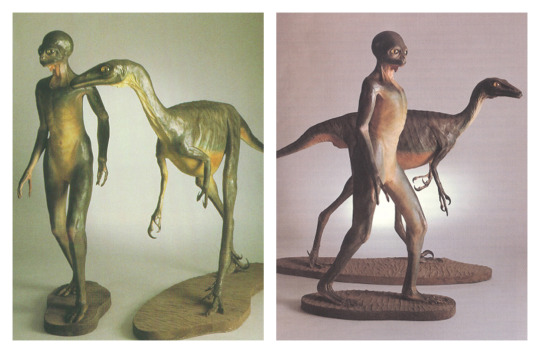
There are two highly-popular, vexing questions about dinosaurs: What would the world look like if these strange and majestic animals had not gone extinct? And, would they ever evolve into intelligent species comparable to humans? In 1982, palaeontologist Dale Russell, after observing “… a general trend toward larger relative brain size in terrestrial vertebrates through geologic time, and the energetic efficiency of an upright posture in slow-moving, bipedal animals”, postulated the Dinosauroid, a humanoid, erect-gaited sophont which may have evolved from Troodon-like dinosaurs had the end-Cretaceous extinction not occurred.

This question occupied the minds of yours truly (seen here on the right), and world-building comic genius Simon Roy (on the left), as well. We were unconvinced by Russell’s Dinosauroid. We thought that an erect, humanoid sophont was too prejudiced towards humans to be realistic. We were instead inspired by zoologist Darren Naish’s writings on the evolution of intelligent, bird-like dinosaurs: “No, post-Cretaceous maniraptorans wouldn’t end up looking like scaly tridactyl plantigrade humanoids with erect tailless bodies. They would be decked out with feathers and brightly coloured skin ornaments; have nice normal horizontal bodies and digitigrade feet; long, hard, powerful jaws; stride around on the savannah kicking the shit out of little mammals; and in the evenings they would stand together in the trees, booming out a duet of du du du-du, a deep noise that would reverberate for miles around…”
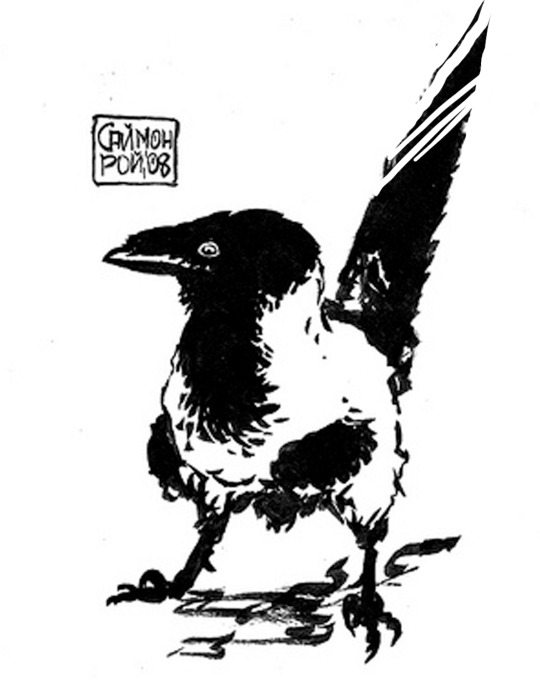
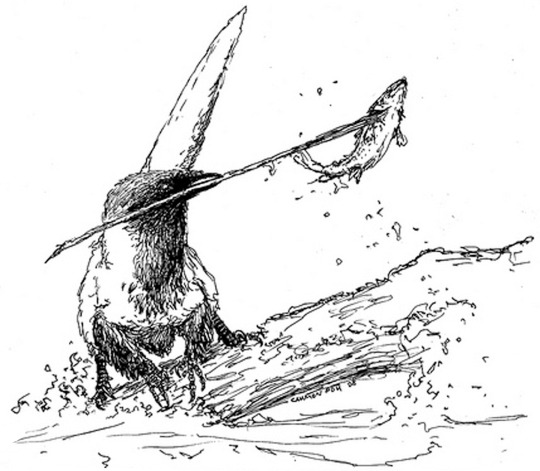
Towards the end of the ‘00s, Simon Roy and I independently began to develop our concepts for bird-like intelligent dinosaurs. Inspired by the ravens he saw around his Canadian home, Simon drew the corvid-like dinosauroids seen above.
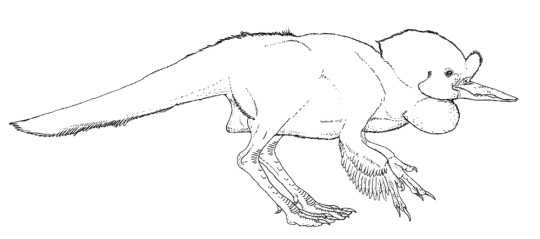
I, in turn, was inspired by ground hornbills, parrots, certain dinosaurs and corvids, and came up with the speculative organism seen above. I named it Avisapiens saurotheos.
Simon and I soon got in touch with each other; and started developing a world and a storyline for our dinosauroids. Our collaborative efforts continued, on-and-off, until the mid-2010s. Our aim was to develop the Dinosauroids story into an illustrated story-book, which we naively hoped to sell to a major sci-fi publisher. But we soon realised that we enjoyed world-building more than writing a story, or putting a book together. We kept bouncing concepts back and forth, but never had a chance to publish them, until now. Most of the body of work you see on this page was drawn by Simon, based on ideas we created together. I also contributed some of the “cave drawings” and certain creature illustrations. This is the first time the totality of our Dinosauroids-universe works has been displayed online.
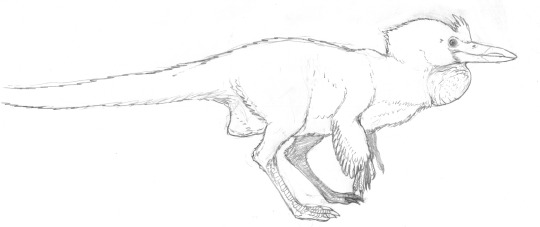
Simon and I refined the design of my original Avisapiens dinosauroid…
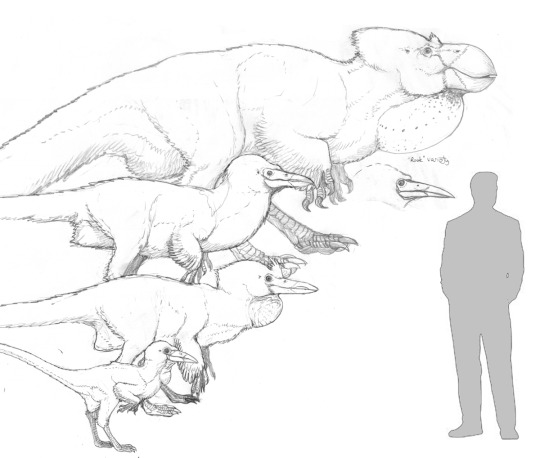
And created a few more sentient races to accompany them. There was one more, slightly-crow-like species of Avisapiens (a continuation of Simon’s corvid dinosauroids - Avisapiens tataricus). These two species were joined by a variety of “forest giants” (Gigantosapiens borealis), and a race of pygmies (Avisapiens minimus).
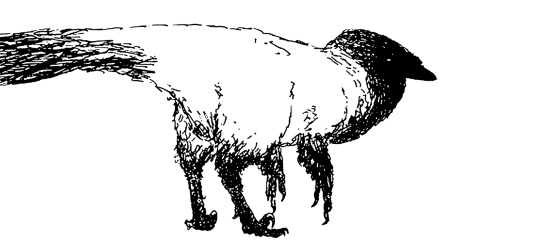
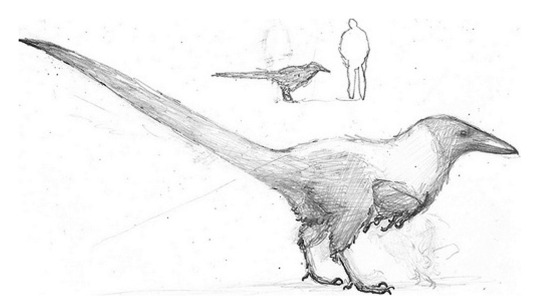

Simon’s refined studies of corvid-like, and pygmy dinosauroids.
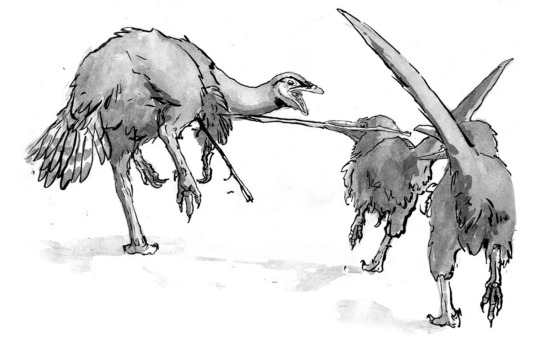
We also designed an extensive selection of animals around our dinosauroids. We predicted that even without the K/T mass extinction, dinosaurs and other animals would have kept on evolving, and many “familiar” groups of dinosaurs would have gone extinct. We thus designed a world where the majority of surviving dinosaurs were the descendants of “maniraptoran” groups; birds, deinonychosaur (“raptor”) dinosaurs, troodonts, oviraptors and therizinosaurs. Here, you can see two boreal dinosauroids using mouth-spears to hunt herbivorous troodont quarry.
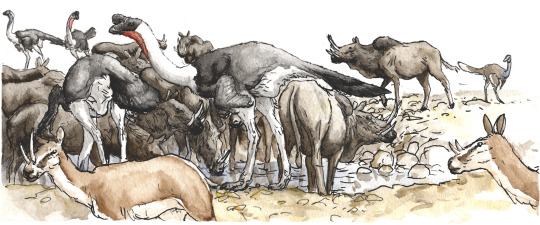
We also did not want this world to be devoid of mammals. Even during the age of dinosaurs, certain mammals evolved into large and sophisticated forms. We envisioned a world where parallel groups of mammals, similar to, but phylogenetically distinct from today’s forms, co-evolved alongside the dinosaurs during their continued reign. The scene above shows an Eurasian water-hole crowded with two species of ornithomimid herbivores (Rugocursor, left-centre; and Cyanogularia, far right); alongside robust (Afrotuberculocamelus) and gracile (Odontocervoides) species of herbivorous mammals which, for the lack of a better term, we decided to name “supermaras”.

A series of studies showing the evolution of supermaras from rodent-like multituberculate mammals. The species depicted here is Ceratomegamys.

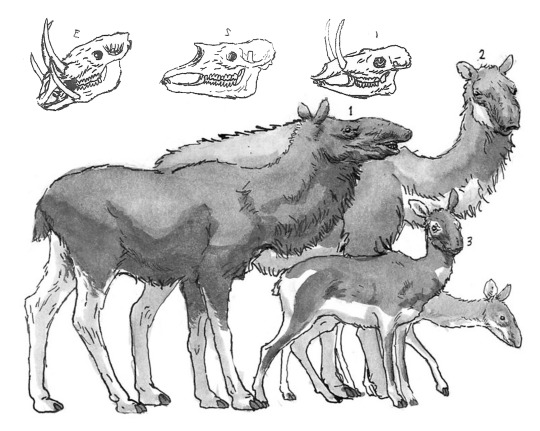
The full diversity of cursorial “supermaras”, from left to right: The burly, tusked Odontobovis; the superficially-camel-like Tuberculocamelus; the gazelle-like Odontocervoides; the trunked, moose-like Pseudalces; and the two related forms - the big, desert-dwelling Macropseudalces; and one of the many deer-like Cervopseudalces species.


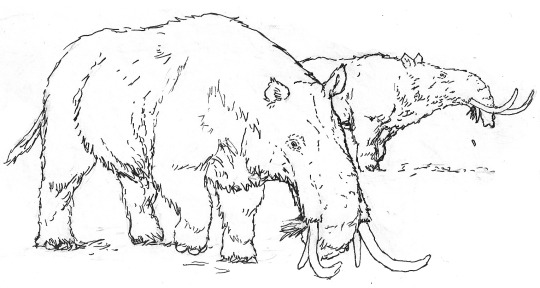
Studies of Megatapirus, large, superficially-elephant-like mammals that live in far-northern climates.


We also derived a variety of mammalian carnivores, mostly from marsupial stock. Through the honing forces of evolution, we imagined some would look very similar to the canid predators we have in the present day - the actual difference would only be in their internal and reproductive anatomies. Above, clockwise: The large, badger-like Mephitursoides; the extremely dog-like Pseudokynos; the hyena-like Krokutadasyurus.

Some marsupial predators diverged from the mammalian body-plan, and evolved into forms roughly converging with the predatory dinosaurs. The raptorial, meat-eating kangaroo-equivalent Theropodoktonos and kin are potent predators in South America.
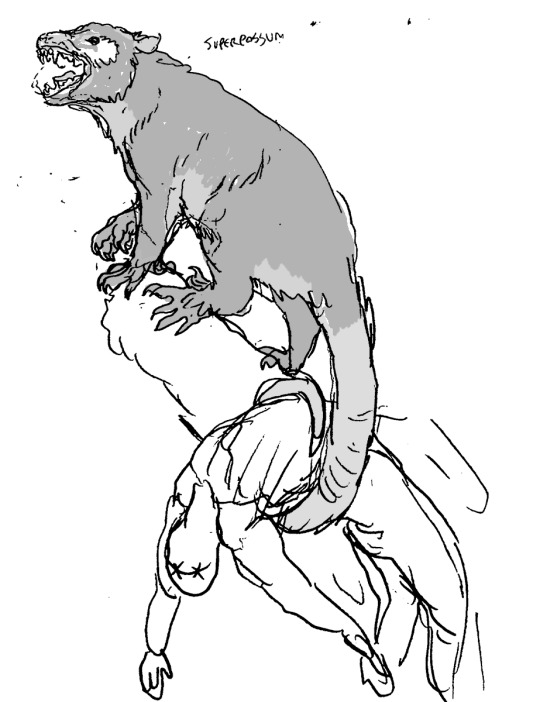

Two more divergent marsupials: The leopard/possum Phobodidelphyoides; and the monkey-like Marsupiolemuris, a social, arboreal form with a potential to evolve intelligence.

We also wanted to have flying reptiles - pterosaurs - still alive and kicking in our world. These extraordinary animals were already in decline by the time dinosaurs became extinct. So we relegated them to only a few roles, comparable to storks and other large water-birds alive today. Above is a flock of Diluvipterus; large, filter-feeding pterosaurs. Also note the solitary duck flying on the upper-left corner.
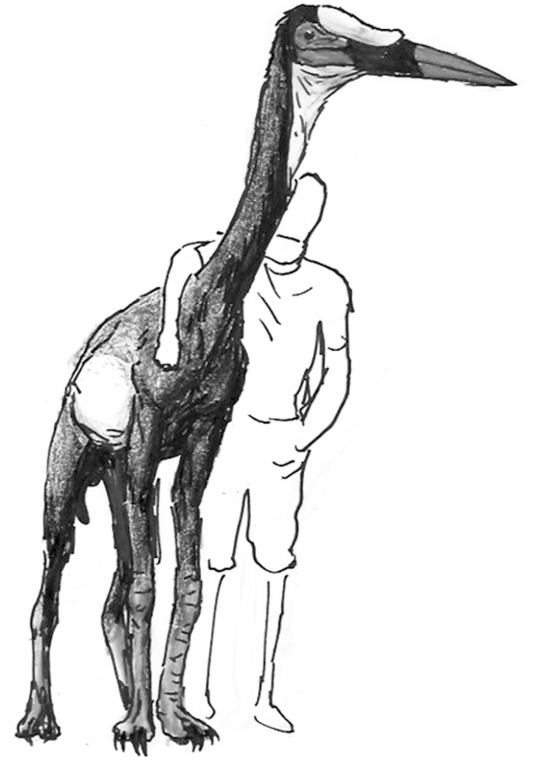
Another, flightless pterosaur, Cygnotherium, from the islands that now make up New Zealand.


A more unusual group are the avisuchians, descendants of maniraptoran dinosaurs that secondarily converged on the aquatic bodyplans of spinosaurs (which are now extinct in this timeline). Most resembled the short-tailed forms, Pisciraptor and Brachyornithoides seen above. These goose-to-dog-sized animals inhabit rivers and lakes, and occupied a niche comparable to otters today.

There were also long-tailed Avisuchians such as the Natatoraptor seen above. These animals inhabit open waters, and nested in estuaries and beaches.

A contemporary scene from Eurasia shows commensal life between mammals and dinosaurs. Two Pseudalces browse peacefully alongside two kinds of large ornithominids, Archganseria and Brontonyx. A tiny, heron-like troodont, Anatolocursor, can be seen between them, looking for small animals flushed out by the large herbivores’ movements.

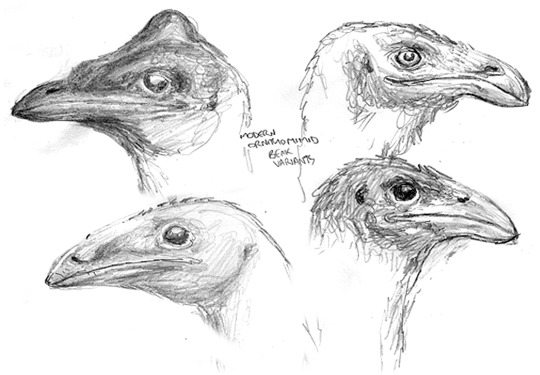
Nevertheless, despite co-existing with large mammals, dinosaurs are more diverse on this world. Herbivorous dinosaurs, such as these derived ornithomimids, constitute a large part of dinosaurian diversity. Above left are studies of Ganseria, a common, medium-sized browser. Above right, clockwise from the top right, are portraits of Ukkuloganser, another medium-sized browser; Nyctodromon, a nocturnal digger; Adzuganser, a small omnivore; and Pyramidoganser, a crested form native to the Nile Delta.

A scaled study of Brontonyx, a heavyweight ornithomimid herbivore.

Portraits of many cursorial dinosaurs from across Eurasia:
1- Leptoganseria, a mountain-dwelling ornithomimid browser found on the mountains of what is now the Caucaus.
2- Ikiridectes, a troodont that mostly hunts small digging mammals.
3- Aktardektes, a small ornithomimid that has specialised for cracking hard-shelled nuts.
4- The gracile, juvenile variant of Brontonyx, (6) which occupies a completely-different ecological niche as a generalist omnivore.
5- Rugocursor, a widespread, broad-beaked ornithomimid with many species, common across North Africa and Eurasia.
6- The adult form of Brontonyx, a gigantic ornithomimid that feeds on trees, and defends itself with heavy claws.
7- A vulture-like Cynornithoides, an extremely bird-like troodont, a frequent commensal of Avisapiens and related intelligent species.

A variety of Rugocursor, a mostly-herbivorous ornithomimid with adaptations for running.
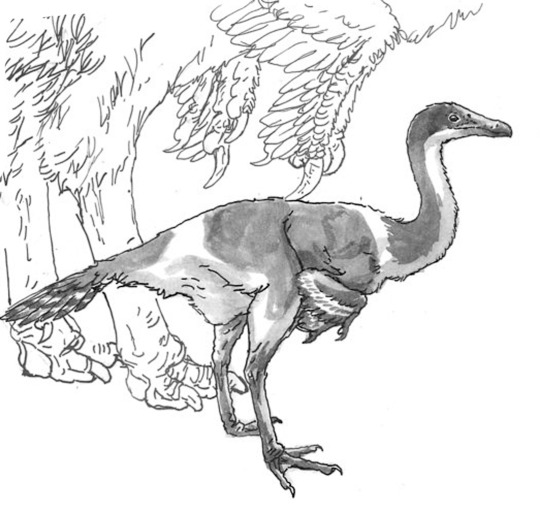
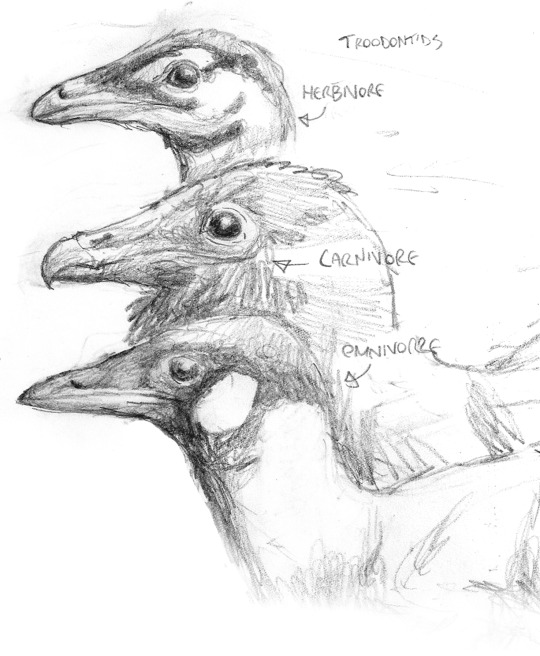
Various troodonts, small-bodied, sometimes very bird-like omnivorous dinosaurs, distantly related to the Avisapiens lineage. Left, shaded study of Variocursor, a common, heron-sized, striding predator on small animals. Right, from top to bottom; Vuuria, a herbivorous form common across Eurasia; Boreocursor, a cold-climate predator, related to the Variocursor seen on the left; and Paravuuria, an omnivorous form.


The last descendants of hadrosaurs, the famous “duck-billed dinosaurs”, still roam in South America. The hoofed, sheep-sized Ornimastax seen above left, is a typical example. Australia, as in our world, is home to an unusual radiation of forms whose relations to animals on other continents are not very clear. Brachygullagong, seen above right, is a troodont-like form whose duck-like skull and batteries of grinding cheek teeth have secondarily converged with those of the hadrosaurs.

The largest herbivores on this world are long-necked, scythe-clawed ornithomimid relatives known as avititans. The largest species on Eurasia is Avititan bicolor, seen above in scale with a human figure.
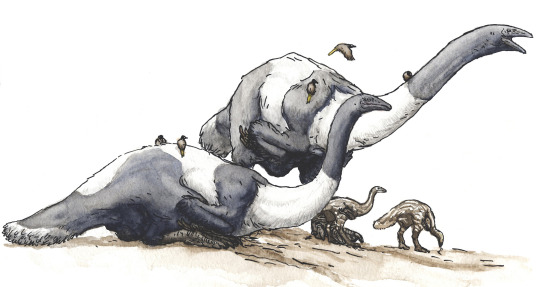
Avititans owe their ecological success to their strong social structures and their care of their young. Here are two Eurasian avititans with their offspring. Yellow-tailed enantiornithine tick-birds, Parasitophagus leucurus, can be seen on their backs.

Oviraptoriformes made up another important clade of dinosaurs in this world.

Descended from bird-like ancestors, various clades of these animals live on as important omnivores, scavengers and even predators in many ecological niches. Above is Eblisornis, a common species found throughout Eurasia.
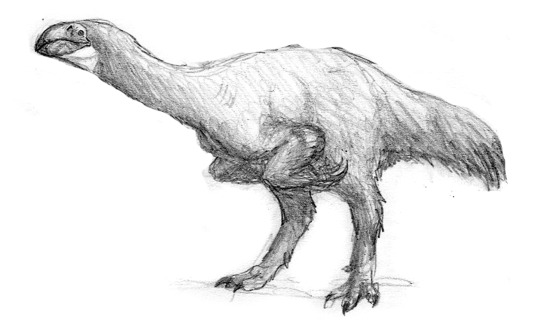
The bull-bird, Bosornithoides erythrops, is the largest and most prominent oviraptoriform on the Eurasian continent. It subsists mostly on plants and fruit, but will eat carrion if given the chance.
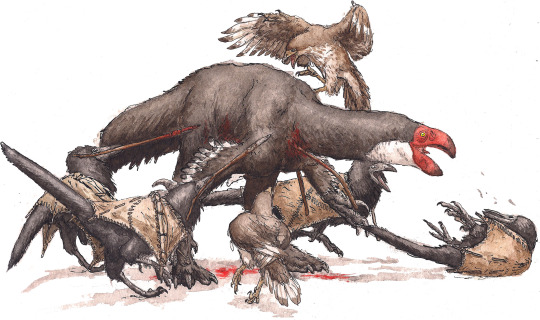
Hunting the wary and dangerous Bosornithoides is an important rite of passage for dinosauroids. The animals require coordination and group-work to bring down, and hunting one is a bonding experience for batches of young-adult nestmates. This ritual not only cements the dinosauroids’ social standing in their tribe, but also bonds the hunters together for the rest of their lives. The four hunters-to-be in this picture are accompanied by a couple of jackal-birds (Cynornithoides), domesticated pets that are almost as smart as the dinosauroids themselves.
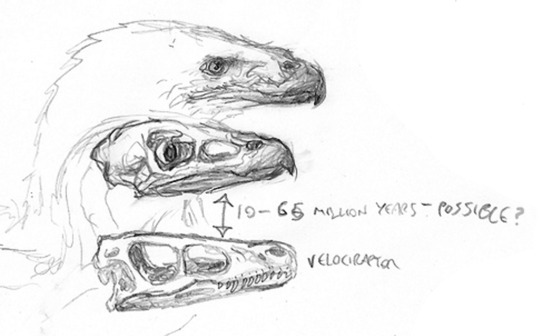
Many dinosaurs dabble in carnivory, but the main predatory niches on this version of Earth, are occupied by a diverse radiation of paradromaeosaurs, descendants of the famous “raptor” dinosaurs and kin. Paradromaeosaurs have diverged considerably from their ancestors. One lineage, known as the rhynchovenators, replaced their teeth with sharp, raptorial beaks.
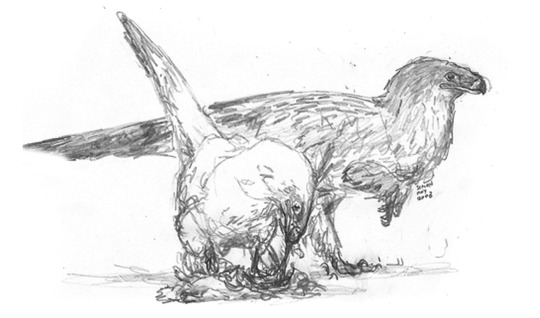
The male and female of the common boreal rhynchovenator, Rhynchovulpes agilis.

A lean-legged Egyptian rhynchovenator, Rhnychovulpes aegypticus, atop a dead multituberculate mammal. The key to rhnychovenators’ success is their added tenacity and stamina. Even a small rhynchovenator can overcome comparatively large prey by continually harassing and chasing it into exhaustion.

The bald-headed Osteophaganax regalis is a common scavenger encountered across the Caucaus Mountains. Its males develop striking, black-and-purple wattles on their faces during spring.
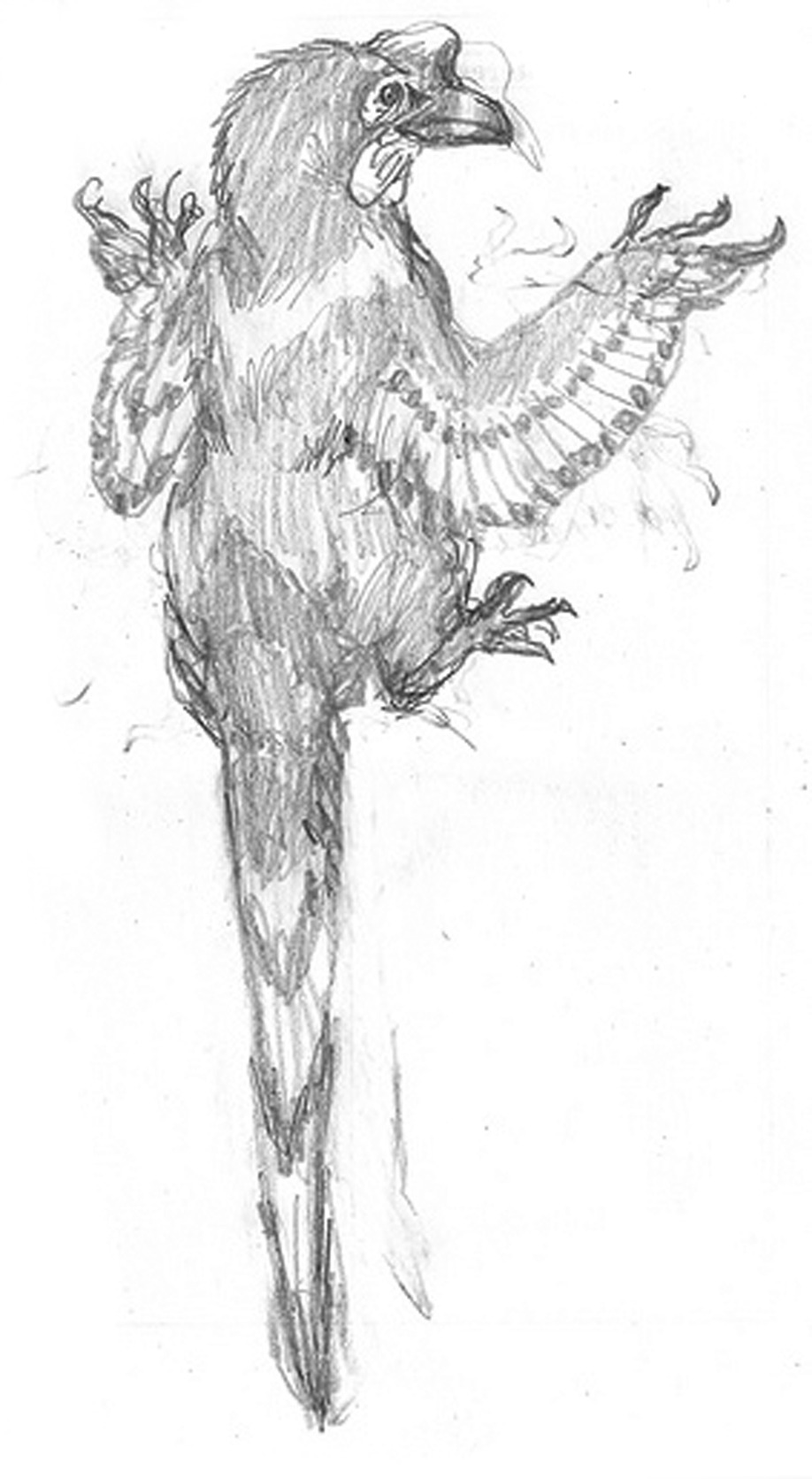

Two more derived troodonts. Left, a tree-dwelling arbosaur, Toucanops dixoni, from one of the diverse and little-understood clades found across the South American continent. Right, the lean, narrow-beaked Halophagus sp. from fossil deposits in what is now China. This group evolved specialisations for marine diving and probably saltwater drinking, before becoming extinct during the Miocene.
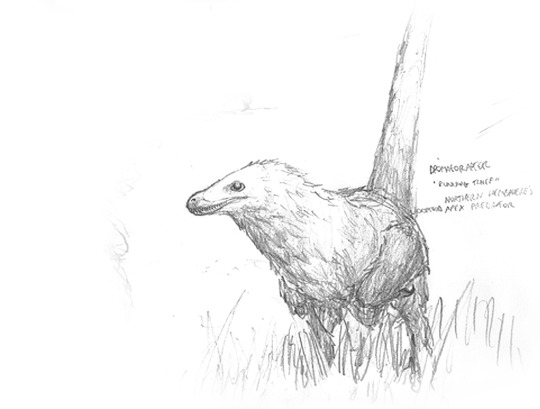
The dominant guild of maniraptoran predators, the tyrannoraptors, evolved from “regular” dromaeosaurs with powerful, biting jaws. Some species living today, such as the Savannahdromeus shown above, are still very similar to the earliest forms. Despite its small size, the smart and social Savannahdromeus are apex predators thanks to their pack-hunting behaviour.

Another basal tyrannoraptor, Pantherdromeus - is a solitary hunter that is common across much of Eurasia. It probably represents a diverse and subtly-variable species complex.

Solitary, basal tyrannoraptors eventually gave rise to the terrifying main-line tyrannoraptors in the last twenty-million years. The evolution of these animals was marked by the reduction of their wings and the enlargement of their legs, and jaws. Their tails developed into stiff and rod-like balancing organs. In some respects, they were the evolutionary echoes of the big-jawed, running tyrannosaurs, which had become extinct earlier on, during this world’s version of the Eocene period. Unlike tyrannosaurs, however, tyrannoraptors had well-developed social behaviours and intelligence; which, when coupled with their fast speed and terrific jaws, turned them into formidable apex predators. Above are the adolescent and mature forms of Metadromodaemon phobetor, a mid-sized hunter found in the Middle East and North Africa.
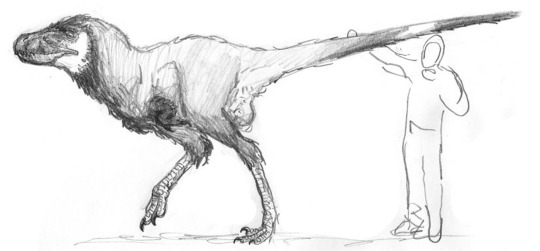
A scaled drawing of Wotandromeus bicolor, the terrifying, large-headed hunter of European forests.
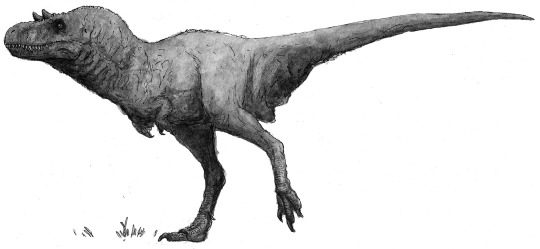
The seven-metre-long Melanorodromeus euceratus - also known by the Dinosauroids as “black thing” - is the largest predator on mainland Eurasia; but even larger forms are reputed to exist in Siberia and North America.

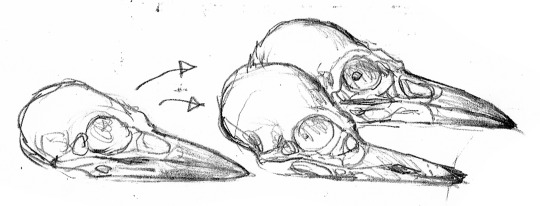
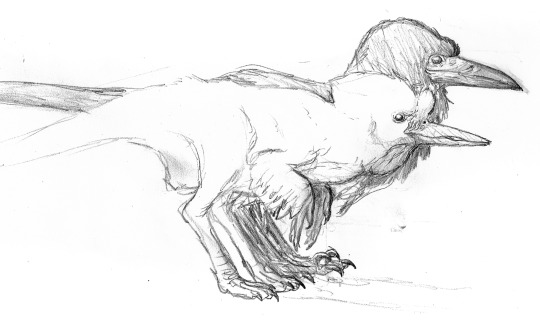
Let us now return to the Dinosauroids, their culture, and art. Above is a brief study illustrating the divergence of the two species of Avisapiens; A. saurotheos and A. tataricus, from ancestral eu-troodontid stock.


Especially A. tataricus shows considerable variation in beak shape, length and colouration. Above, right are the colouration of the Eurasian (top right, bluish-black), and Northeast Siberian (above right, yellowish-brown) races. Above, left shows a spectrum of variation in A. tataricus beaks. The cross-beaked and long, curved beaks occasionally crop up in certain bloodlines, which also have augmented song-memories. These individuals are revered as shamans in certain A. tataricus tribes; or are immediately killed-off as harbingers of doom in others.
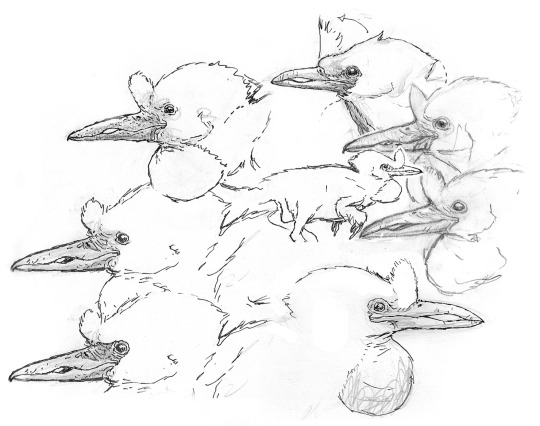
Above, the extensive variation in the head shapes, beak lengths and crests of various races in A. saurotheos. The bottom-right sketch depicts a hybrid individual between A. saurotheos and A. tataricus.

A powerful hunter of A. tataricus, from the Carpathian Mountains, showing a stone axe and bent spear that are characteristically used by this particular tribe.
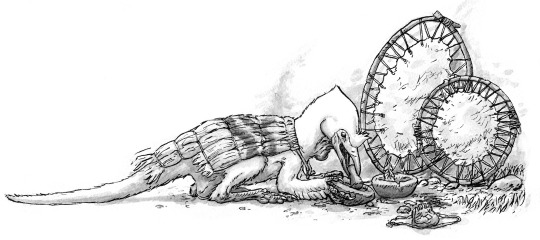
An artist/shaman of one of the settled A. saurotheos tribes living around the Balkans. He paints on animal skins stretched taut across circular frames, and paints using ground-up soil and other pigments, wielding a brush made from a wing-feather. The skin canvas also double as drums.
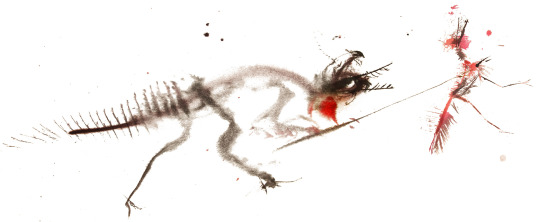
Art is one sure-fire way of identifying an intelligent species. This skin-painting shows a spear-hunter and prey, a painting by the aforementioned shaman.

Painting of a god or hero-figure with red tail feathers.
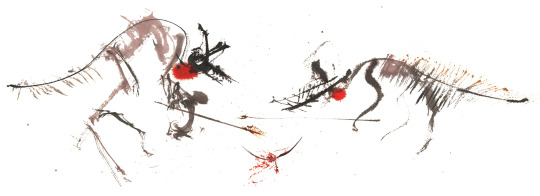
Painting of two shamans divining the future from the entrails of a dead flying animal.
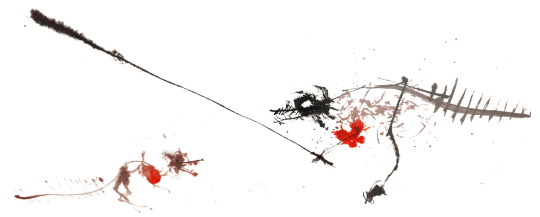
Painting of a hatchling being trained by a village elder.
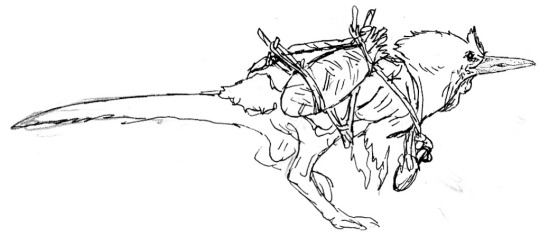

Studies of an A. saurotheos wanderer with a travel harness; and a duo of A. tataricus migrants with a domesticated bull-bird, a relative of the oviraptoriform Bosornithoides mentioned above.
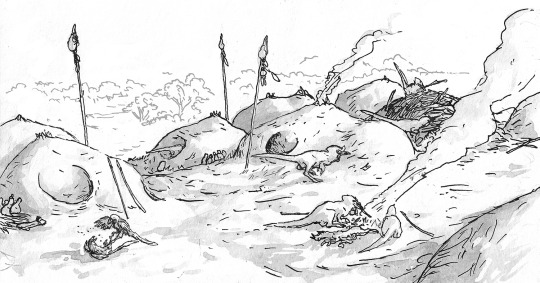
The view from an Avisapiens saurotheos village, showing the species’ characteristic nest-houses, and a pair of semidomesticated Cynornithoides jackal-birds playing in the village square. Note the heads mounted on tall poles, a sign of reverence to the spirits of the departed.
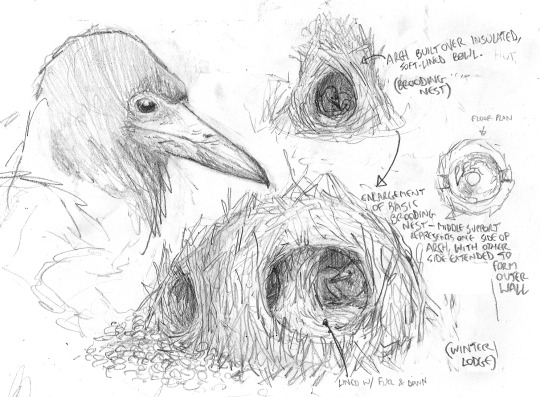
Detail of a brooding nest constructed by Avisapiens tataricus. Most tribes of these species are migrants that range across Eurasia, few build permanent structures.

Sketch of an A. tataricus wearing a travois-like travel harness.

Study of an A. saurotheos wanderer with travel gear.
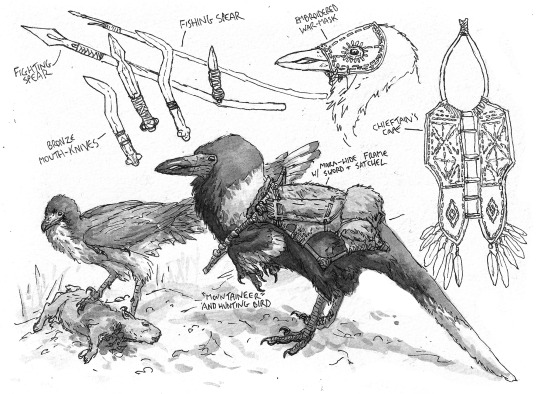
A detailed study of the burly A. tataricus native to the Caucaus Mountains, complete with weapons, travel gear and ornamental cape.

Sketches of war-like A. tataricus tribes native to the Eastern Mediterranean region. These tribes are known for their ferocious (if impractical) war-masks.
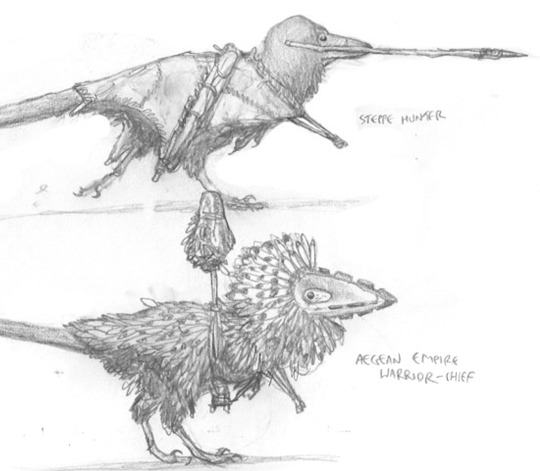
Studies of two different warriors from two different Avisapiens tataricus societies.
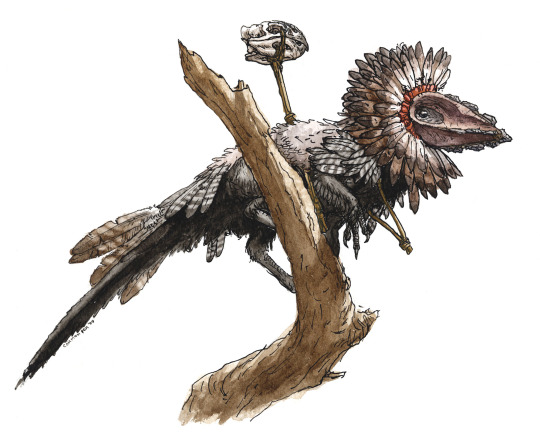
A resplendent A. tataricus warrior from the Levant, wearing an ornate head-dress of feathers, and an obsidian-studded war-mask.

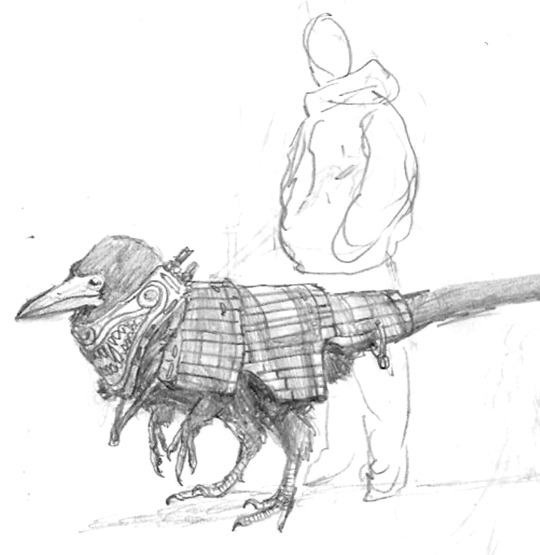
Studies for Avisapiens spear-throwers and wooden-slat armour; from a comparatively advanced period on this species’ societal development.

An A. saurotheos shaman entertains hatchlings with fireside tales of spirits and other worlds.

A band of slave-keeping A. tataricus warriors during a raid to an A. saurotheos village. A young shaman is captured and de-clawed.

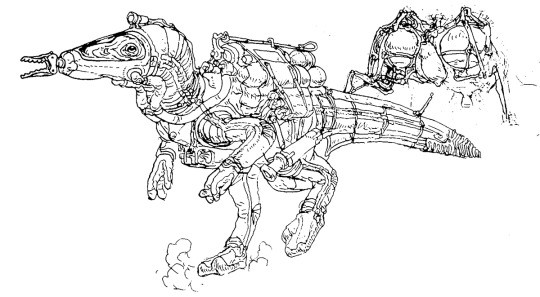
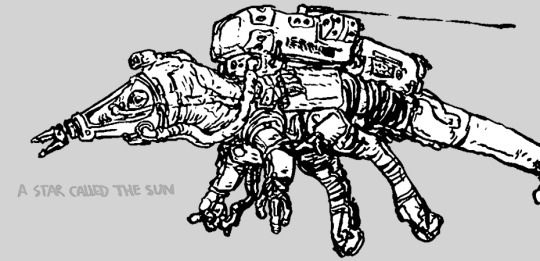
Simon Roy and I also dwelled on the far-future evolution of dinosauroid technology. The sketches above of a “knight”, moon lander and an astronaut were produced, but we did not pursue these scenarios seriously.

Let us conclude our visit to the dinosauroid tangent-universe with one last look at our artist/shaman, his village, and his paintings. Somewhere in deep time, they are still alive, and still waiting to tell us of their adventures.
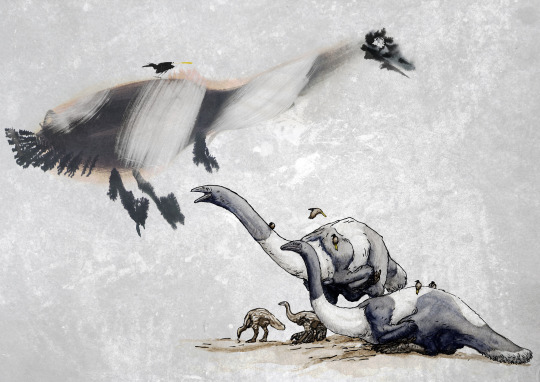
A painting of an avititan family.

A painting of the dangerous, predatory “black thing”.
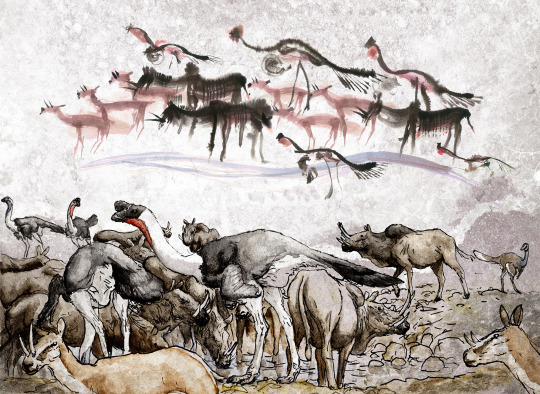
A painting showing numerous animals at a watering hole.

A painting showing an A. tataricus warrior.
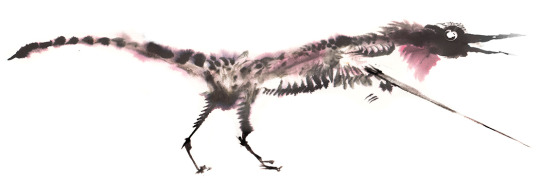

Stylised paintings of spear-wielding Carpathian warriors.

Painting of a ferocious Aegean headhunter.

A stylised painting showing an immature dinosauroid.
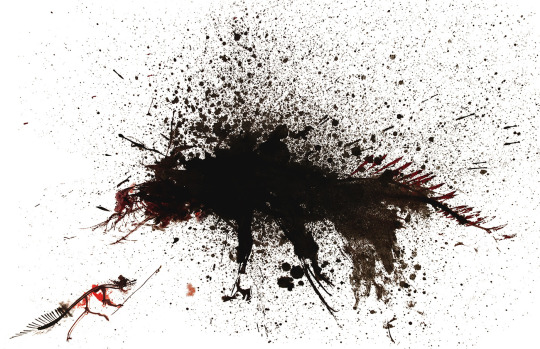
Stylised painting of a warrior confronting a spirit-creature.

Stylised painting of a powerful Caucausian mountain warrior.

Painting showing a ghoul-like oviraptoriform animal.

Painting of one of the sky-gods worshipped by A. saurotheos.
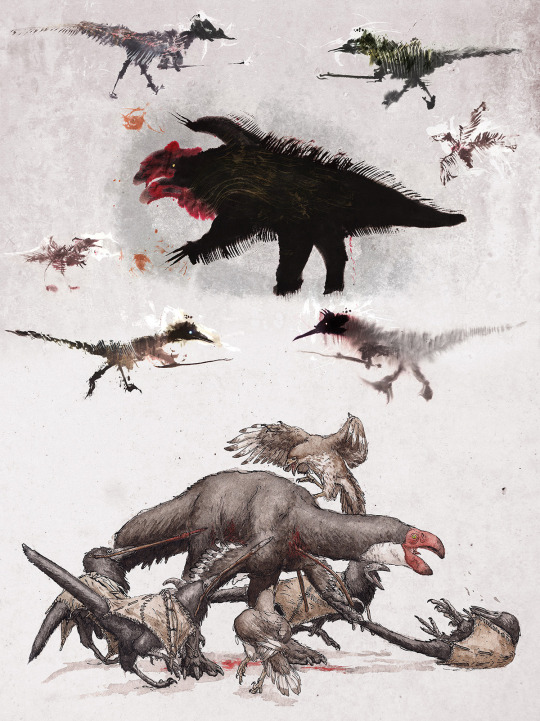
A complex painting showing four A. tataricus warriors hunting a bull Bosornithoides.
Simon Roy and I may return to the dinosauroids universe one day with a real story; but truth be told we enjoyed world-building far more than inventing stories and characters.
- 2008 - 10/2019.
#worldbuilding#speculative biology#speculative evolution#dinosaurs#dinosaur art#dinosauroids#paleoart#creature design#c m kosemen#simon roy
431 notes
·
View notes
Text

The screen and stage star is making his Broadway debut as the bottled-up husband wearing a “mask of control” in Harold Pinter’s romantic triangle.

[ By Laura Collins-Hughes
Aug. 21, 2019, 5:00 a.m. ET ]
Tom Hiddleston was posing for a portrait, and the face he showed the camera wasn’t entirely his own.
That had been his idea, to slip for a few moments into the character he’s playing on Broadway, in Harold Pinter’s “Betrayal”: Robert, the cheated-on husband and backstabbed best friend whose coolly proper facade is the carapace containing a crumbling man. And when Mr. Hiddleston became him, the change was instantaneous: the guarded stillness of his body, the chill reserve in his gray-blue eyes.
“It’s interesting,” Mr. Hiddleston said after a while, analyzing Robert’s expression from the inside. “It gives less away.” A pause, and then his own smile flickered back, its pleasure undisguised. “O.K.,” Mr. Hiddleston announced, himself again, “it’s not Robert anymore.”
It was late on a muggy August morning, one day before the show’s first preview at the Bernard B. Jacobs Theater, and Mr. Hiddleston — the classically trained British actor best known for playing the winsomely chaotic villain Loki, god of mischief and brother of Thor, in the Marvel film franchise — had been in New York for less than a week.
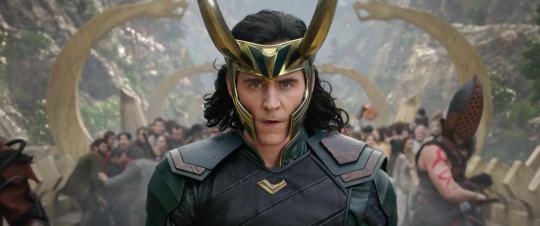
He’ll be here all autumn for the limited run of the production, a hit in London earlier this year, but he wasn’t going to pretend that he’d settled in. “I literally have never sat in this room before,” he’d said at the top of the photo shoot, in his cramped auxiliary dressing room, next door to the similarly tiny one he had been occupying.
He’d had nothing to do with the space’s camera-ready décor. So there was no use making a metaphor of the handsome clock with its hands stopped at 12 (“Betrayal” is famous for its reverse chronology; far more apt if the clock had run backward), or of the compact stack of pristine books that looked like journals, with pretty covers and presumably empty pages: a bit off-brand for Mr. Hiddleston, who at 38 has a model-perfect exterior with quite a lot inscribed inside.
Take the matter-of-fact way he said, in explaining that he’d first encountered Pinter’s work when he studied for his A-levels in English literature, theater, Latin and Greek: “It was a real tossup between French and Spanish or Latin and Greek. I thought, I can always speak French and Spanish, I can’t always read Latin and Greek, so I’ll study that and I’ll speak the other two.”
Though, to be fair, he only said that because I’d teased him slightly about the Latin and Greek, and I’d teased him — not a recommended journalistic technique — because he was so disarmingly good-humored and resolutely down to earth, chatting away as he waited for the photographer to set up a shot. It didn’t seem like it would ruffle him. He laughed, actually.
From a one-night reading to Broadway
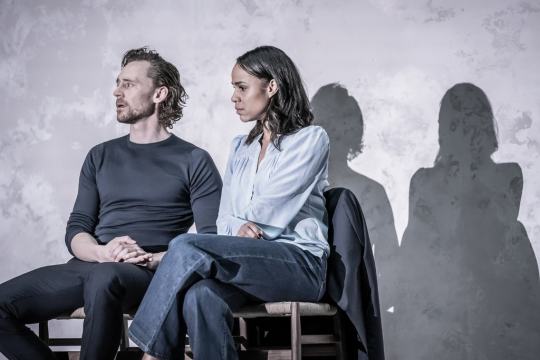
In this country, Mr. Hiddleston is mainly a screen star, known also for playing Jonathan Pine in the John le Carré series “The Night Manager” on AMC. There are plans, too, for him to bring Loki to Disney’s streaming service in a stand-alone series.
But at home in London, he has amassed some impressive Shakespearean credits, including the title roles in Kenneth Branagh’s “Hamlet” and Josie Rourke’s “Coriolanus,” and a turn as Cassio in Michael Grandage’s “Othello” — a production that Pinter, saw some months before he died in 2008. That was the year Mr. Hiddleston won a best newcomer Olivier Award for Cheek by Jowl’s “Cymbeline.”
Jamie Lloyd’s “Betrayal,” which has a staging to match the spareness of Pinter’s language and a roiling well of squelched emotion to feed its comedy, is Mr. Hiddleston’s Broadway debut. Likewise for his co-stars, Zawe Ashton (of Netflix’s “Velvet Buzzsaw”), who plays Emma, Robert’s wife; and Charlie Cox (of Netflix’s “Daredevil”), who plays Emma’s lover, Jerry, Robert’s oldest friend.
Beginning at what appears to be the end of Robert and Emma’s marriage, after her yearslong affair with Jerry has sputtered to a stop, it’s a drama of cascading double-crosses. First staged by Peter Hall in London in 1978 — and in 1980 on Broadway, where it starred Roy Scheider, Blythe Danner and Raul Julia — it rewinds through time to the sozzled evening when Emma and Jerry overstep the line.
The most recent Broadway revival was just six years ago, directed by Mike Nichols and starring Daniel Craig as Robert, Rachel Weisz as Emma and Rafe Spall as Jerry. It might seem too soon for another, let alone one with sexiness to spare — except that Mr. Lloyd’s production is also marked by a palpable hauntedness and a profound sense of loss.
Reviewing the London staging in The New York Times, Matt Wolf called it “a benchmark achievement for everyone involved,” showing the play “in a revealing, even radical, new light.” Michael Billington, in The Guardian, called Mr. Hiddleston’s performance “superb.”
What’s curious is that Mr. Hiddleston, so good at bad boys, isn’t playing Jerry, the more glamorous role: the cad, the pursuer, the best man who goes after the bride. But Mr. Lloyd said that casting him that way was never part of their discussions.
Last fall, when Mr. Lloyd persuaded Mr. Hiddleston to read a scene with Ms. Ashton for a one-night gala celebration of Pinter in London, part of the season-long Pinter at the Pinter series, there was no grand plan. Having asked Mr. Hiddleston about a possible collaboration for years, since “just before he became ridiculously famous,” Mr. Lloyd said, this was the first time he got a yes.
“I just really admired his craft of acting, the precision of his acting, as well as his real emotional depth and his real wit,” Mr. Lloyd said. “And he’s turned into what I think is the epitome of a great Pinter actor. Because if you’re in a Pinter play, you have to dig really deep and connect to terrible loss or excruciating pain, often massive volcanic emotion, and then you have to bottle it all up. You have to suppress it all.”
This, he added, is what Mr. Hiddleston does in “Betrayal,” where characters’ meaning is found between and behind the words, not inside them.
“Some of the pain that he’s created in Robert, it’s just unbearable, and yet he always keeps a lid on it,” Mr. Lloyd said.
The scene Mr. Hiddleston and Ms. Ashton read at the gala appears at the midpoint of “Betrayal”: Robert and Emma on vacation in Venice, at a moment that leaves their marriage with permanent damage. Within days, Mr. Hiddleston told Mr. Lloyd that he was on board for a full production.

‘What remains private’
Photos taken, back in the faintly more lived-in of his Broadway dressing rooms, Mr. Hiddleston opened the window to let in some Midtown air — and when you’re as tall as he is, 6 feet 2 inches, opening it from the top of the window frame is easy enough to do. Then, making himself an espresso with his countertop machine, he sat down to talk at length.
“I’m always curious about the presentation of a character’s external persona versus the interior,“ he said. “What remains private, hidden, concealed, protected, and what does the character allow to be seen? We all have a very complex internal world, and not all of that is on display in our external reality.”
He can tick off the ways that various characters of his conceal what’s inside: Loki, with all that rage and vulnerability “tucked away”; the ultra-proper spy Jonathan Pine, in “The Night Manager,” “hiding behind his politeness”; Robert, a lonely man wearing “a mask of control” that renders him “confident, powerful, polished,” at least as far as any onlookers can tell.
In “Betrayal,” each of the three principals has an enormous amount to hide from the people who are meant to be their closest intimates. It’s a play about power and manipulation, duplicity and misplaced trust, and what’s so threatening about it is the very ordinariness of its privileged milieu. This snug little world that once seemed so safe and ideal — the happiest of families, the oldest of friends — has long since fallen apart.
But to Mr. Hiddleston, Pinter’s drama contains two themes just as significant as betrayal: isolation and loneliness.
“The sadness in the play — it’s not only sadness; because it’s Pinter, there’s wit and levity as well — but if there is sadness in the play,” he said, “I think it comes from the fact that these betrayals render Robert, Emma and Jerry more alone than they were before.”
Trust and self-protection
One-on-one, Mr. Hiddleston was more cautious than he’d been during the photo shoot, surrounded then by a gaggle of people affiliated with the show. Still, when I asked him about betrayal, lowercase, he went straight to the condition it violates.
“To trust is a profound commitment, and to trust is to make oneself vulnerable,” he said, fidgeting with a red rubber band and choosing his words with care. “It’s such an optimistic act, because you’re putting your faith in the hands of someone or something which you expect to remain constant, even if the circumstances change.”
“I’m disappearing down a rabbit hole here,” he said, “but I think about it a lot. I think about certainty and uncertainty. Trust is a way of managing uncertainty. It’s a way of finding security in saying, ‘Perhaps all of this is uncertain, but I trust you.’ Or, ‘I trust this.’ And there’s a lot of uncertainty in the world at the moment, so it becomes harder to trust, I suppose.”
An interview itself is an act of trust, albeit often a wary one. And there was one stipulated no-go zone in this encounter, a condition mentioned by a publicist only after I’d arrived: No talk of Taylor Swift, with whom Mr. Hiddleston had a brief, intense, headline-generating romance that, post-breakup, she evidently spun into song lyrics.
That was three years ago, and I hadn’t been planning to bring her up; given the context of the play, though, make of that prohibition what you will. Mr. Hiddleston, who once had a tendency to pour his heart out to reporters, knows that he can’t stop you.
“It’s not possible, and nor should it be possible, to control what anyone thinks about you,” he said. “Especially if it’s not based in any, um —” he gave a soft, joyless laugh — “if it’s not based in any reality.”
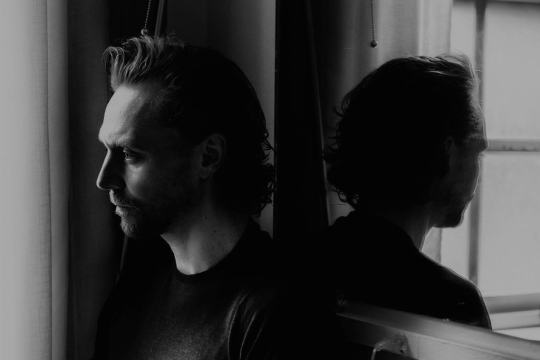
That’s something he’s learned about navigating fame — about being put on a pedestal that’s then kicked out from under him. He knows now “to let go of the energy that comes toward me, be it good or bad,” he said. “Because naturally in the early days I took responsibility for it.”
“And yes, I’m protective about my internal world now in probably a different way,” he added, his tone as restrained as his words. He took a beat, and so much went unsaid in what he said next: “That’s because I didn’t realize it needed protecting before.”
Even so, he doesn’t give the impression of having closed himself off. When something genuinely made him laugh, he smiled a smile that cracked his face wide open.
And the way he treated the people around him at work — with a fundamental respect, regardless of rank, and no whiff of flattery — made him seem sincere about what he called “staying true to the part of myself that’s quite simple, that’s quite ordinary.”
That investment in his ordinariness, as he put it, is a hedge against the destabilizing trappings of fame, but it doubles as a way of protecting his craft.
It’s also of a piece with his insistence that vulnerability is a necessary risk to take, at least sometimes.
“If you go through life without connecting to people,” he asked, “how much could you call that a life?”
#tom hiddleston#hiddles#twhiddleston#the new york times#Betrayal#harold pinter play#Betrayal Broadway#bernard b jacobs theater#August 21 2019#Devin Yalkin#tom hiddleston interview#loki#tom hiddleston portrait#black and white photography#new york city#link to original article in source
701 notes
·
View notes
Link
Tom Hiddleston was posing for a portrait, and the face he showed the camera wasn’t entirely his own.
That had been his idea, to slip for a few moments into the character he’s playing on Broadway, in Harold Pinter’s “Betrayal”: Robert, the cheated-on husband and backstabbed best friend whose coolly proper facade is the carapace containing a crumbling man. And when Mr. Hiddleston became him, the change was instantaneous: the guarded stillness of his body, the chill reserve in his gray-blue eyes.
“It’s interesting,” Mr. Hiddleston said after a while, analyzing Robert’s expression from the inside. “It gives less away.” A pause, and then his own smile flickered back, its pleasure undisguised. “O.K.,” Mr. Hiddleston announced, himself again, “it’s not Robert anymore.”
It was late on a muggy August morning, one day before the show’s first preview at the Bernard B. Jacobs Theater, and Mr. Hiddleston — the classically trained British actor best known for playing the winsomely chaotic villain Loki, god of mischief and brother of Thor, in the Marvel film franchise — had been in New York for less than a week.

He’ll be here all autumn for the limited run of the production, a hit in London earlier this year, but he wasn’t going to pretend that he’d settled in. “I literally have never sat in this room before,” he’d said at the top of the photo shoot, in his cramped auxiliary dressing room, next door to the similarly tiny one he had been occupying.
He’d had nothing to do with the space’s camera-ready décor. So there was no use making a metaphor of the handsome clock with its hands stopped at 12 (“Betrayal” is famous for its reverse chronology; far more apt if the clock had run backward), or of the compact stack of pristine books that looked like journals, with pretty covers and presumably empty pages: a bit off-brand for Mr. Hiddleston, who at 38 has a model-perfect exterior with quite a lot inscribed inside.
Take the matter-of-fact way he said, in explaining that he’d first encountered Pinter’s work when he studied for his A-levels in English literature, theater, Latin and Greek: “It was a real tossup between French and Spanish or Latin and Greek. I thought, I can always speak French and Spanish, I can’t always read Latin and Greek, so I’ll study that and I’ll speak the other two.”
Though, to be fair, he only said that because I’d teased him slightly about the Latin and Greek, and I’d teased him — not a recommended journalistic technique — because he was so disarmingly good-humored and resolutely down to earth, chatting away as he waited for the photographer to set up a shot. It didn’t seem like it would ruffle him. He laughed, actually.
From a one-night reading to Broadway

In this country, Mr. Hiddleston is mainly a screen star, known also for playing Jonathan Pine in the John le Carré series “The Night Manager” on AMC. There are plans, too, for him to bring Loki to Disney’s streaming service in a stand-alone series.
But at home in London, he has amassed some impressive Shakespearean credits, including the title roles in Kenneth Branagh’s “Hamlet” and Josie Rourke’s “Coriolanus,” and a turn as Cassio in Michael Grandage’s “Othello” — a production that Pinter, saw some months before he died in 2008. That was the year Mr. Hiddleston won a best newcomer Olivier Award for Cheek by Jowl’s “Cymbeline.”
Jamie Lloyd’s “Betrayal,” which has a staging to match the spareness of Pinter’s language and a roiling well of squelched emotion to feed its comedy, is Mr. Hiddleston’s Broadway debut. Likewise for his co-stars, Zawe Ashton (of Netflix’s “Velvet Buzzsaw”), who plays Emma, Robert’s wife; and Charlie Cox (of Netflix’s “Daredevil”), who plays Emma’s lover, Jerry, Robert’s oldest friend.
Beginning at what appears to be the end of Robert and Emma’s marriage, after her yearslong affair with Jerry has sputtered to a stop, it’s a drama of cascading double-crosses. First staged by Peter Hall in London in 1978 — and in 1980 on Broadway, where it starred Roy Scheider, Blythe Danner and Raul Julia — it rewinds through time to the sozzled evening when Emma and Jerry overstep the line.
The most recent Broadway revival was just six years ago, directed by Mike Nichols and starring Daniel Craig as Robert, Rachel Weisz as Emma and Rafe Spall as Jerry. It might seem too soon for another, let alone one with sexiness to spare — except that Mr. Lloyd’s production is also marked by a palpable hauntedness and a profound sense of loss.
Reviewing the London staging in The New York Times, Matt Wolf called it “a benchmark achievement for everyone involved,” showing the play “in a revealing, even radical, new light.” Michael Billington, in The Guardian, called Mr. Hiddleston’s performance “superb.”
What’s curious is that Mr. Hiddleston, so good at bad boys, isn’t playing Jerry, the more glamorous role: the cad, the pursuer, the best man who goes after the bride. But Mr. Lloyd said that casting him that way was never part of their discussions.
Last fall, when Mr. Lloyd persuaded Mr. Hiddleston to read a scene with Ms. Ashton for a one-night gala celebration of Pinter in London, part of the season-long Pinter at the Pinter series, there was no grand plan. Having asked Mr. Hiddleston about a possible collaboration for years, since “just before he became ridiculously famous,” Mr. Lloyd said, this was the first time he got a yes.
“I just really admired his craft of acting, the precision of his acting, as well as his real emotional depth and his real wit,” Mr. Lloyd said. “And he’s turned into what I think is the epitome of a great Pinter actor. Because if you’re in a Pinter play, you have to dig really deep and connect to terrible loss or excruciating pain, often massive volcanic emotion, and then you have to bottle it all up. You have to suppress it all.”
This, he added, is what Mr. Hiddleston does in “Betrayal,” where characters’ meaning is found between and behind the words, not inside them.
“Some of the pain that he’s created in Robert, it’s just unbearable, and yet he always keeps a lid on it,” Mr. Lloyd said.
The scene Mr. Hiddleston and Ms. Ashton read at the gala appears at the midpoint of “Betrayal”: Robert and Emma on vacation in Venice, at a moment that leaves their marriage with permanent damage. Within days, Mr. Hiddleston told Mr. Lloyd that he was on board for a full production.
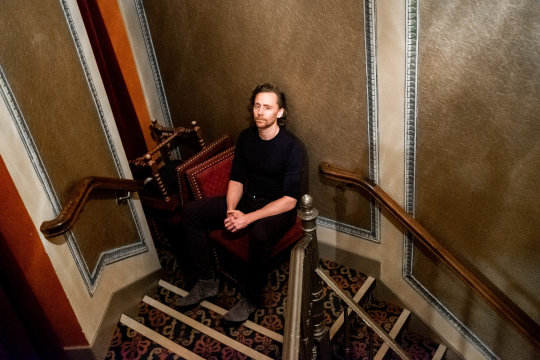
‘What remains private’
Photos taken, back in the faintly more lived-in of his Broadway dressing rooms, Mr. Hiddleston opened the window to let in some Midtown air — and when you’re as tall as he is, 6 feet 2 inches, opening it from the top of the window frame is easy enough to do. Then, making himself an espresso with his countertop machine, he sat down to talk at length.
“I’m always curious about the presentation of a character’s external persona versus the interior,“ he said. “What remains private, hidden, concealed, protected, and what does the character allow to be seen? We all have a very complex internal world, and not all of that is on display in our external reality.”
He can tick off the ways that various characters of his conceal what’s inside: Loki, with all that rage and vulnerability “tucked away”; the ultra-proper spy Jonathan Pine, in “The Night Manager,” “hiding behind his politeness”; Robert, a lonely man wearing “a mask of control” that renders him “confident, powerful, polished,” at least as far as any onlookers can tell.
In “Betrayal,” each of the three principals has an enormous amount to hide from the people who are meant to be their closest intimates. It’s a play about power and manipulation, duplicity and misplaced trust, and what’s so threatening about it is the very ordinariness of its privileged milieu. This snug little world that once seemed so safe and ideal — the happiest of families, the oldest of friends — has long since fallen apart.
But to Mr. Hiddleston, Pinter’s drama contains two themes just as significant as betrayal: isolation and loneliness.
“The sadness in the play — it’s not only sadness; because it’s Pinter, there’s wit and levity as well — but if there is sadness in the play,” he said, “I think it comes from the fact that these betrayals render Robert, Emma and Jerry more alone than they were before.”
Trust and self-protection
One-on-one, Mr. Hiddleston was more cautious than he’d been during the photo shoot, surrounded then by a gaggle of people affiliated with the show. Still, when I asked him about betrayal, lowercase, he went straight to the condition it violates.
“To trust is a profound commitment, and to trust is to make oneself vulnerable,” he said, fidgeting with a red rubber band and choosing his words with care. “It’s such an optimistic act, because you’re putting your faith in the hands of someone or something which you expect to remain constant, even if the circumstances change.”
“I’m disappearing down a rabbit hole here,” he said, “but I think about it a lot. I think about certainty and uncertainty. Trust is a way of managing uncertainty. It’s a way of finding security in saying, ‘Perhaps all of this is uncertain, but I trust you.’ Or, ‘I trust this.’ And there’s a lot of uncertainty in the world at the moment, so it becomes harder to trust, I suppose.”
An interview itself is an act of trust, albeit often a wary one. And there was one stipulated no-go zone in this encounter, a condition mentioned by a publicist only after I’d arrived: No talk of Taylor Swift, with whom Mr. Hiddleston had a brief, intense, headline-generating romance that, post-breakup, she evidently spun into song lyrics.
That was three years ago, and I hadn’t been planning to bring her up; given the context of the play, though, make of that prohibition what you will. Mr. Hiddleston, who once had a tendency to pour his heart out to reporters, knows that he can’t stop you.
“It’s not possible, and nor should it be possible, to control what anyone thinks about you,” he said. “Especially if it’s not based in any, um —” he gave a soft, joyless laugh — “if it’s not based in any reality.”

That’s something he’s learned about navigating fame — about being put on a pedestal that’s then kicked out from under him. He knows now “to let go of the energy that comes toward me, be it good or bad,” he said. “Because naturally in the early days I took responsibility for it.”
“And yes, I’m protective about my internal world now in probably a different way,” he added, his tone as restrained as his words. He took a beat, and so much went unsaid in what he said next: “That’s because I didn’t realize it needed protecting before.”
Even so, he doesn’t give the impression of having closed himself off. When something genuinely made him laugh, he smiled a smile that cracked his face wide open.
And the way he treated the people around him at work — with a fundamental respect, regardless of rank, and no whiff of flattery — made him seem sincere about what he called “staying true to the part of myself that’s quite simple, that’s quite ordinary.”
That investment in his ordinariness, as he put it, is a hedge against the destabilizing trappings of fame, but it doubles as a way of protecting his craft.
It’s also of a piece with his insistence that vulnerability is a necessary risk to take, at least sometimes.
“If you go through life without connecting to people,” he asked, “how much could you call that a life?”
116 notes
·
View notes
Link
Tom Hiddleston was posing for a portrait, and the face he showed the camera wasn’t entirely his own.
That had been his idea, to slip for a few moments into the character he’s playing on Broadway, in Harold Pinter’s “Betrayal”: Robert, the cheated-on husband and backstabbed best friend whose coolly proper facade is the carapace containing a crumbling man. And when Mr. Hiddleston became him, the change was instantaneous: the guarded stillness of his body, the chill reserve in his gray-blue eyes.
“It’s interesting,” Mr. Hiddleston said after a while, analyzing Robert’s expression from the inside. “It gives less away.” A pause, and then his own smile flickered back, its pleasure undisguised. “O.K.,” Mr. Hiddleston announced, himself again, “it’s not Robert anymore.”
It was late on a muggy August morning, one day before the show’s first preview at the Bernard B. Jacobs Theater, and Mr. Hiddleston — the classically trained British actor best known for playing the winsomely chaotic villain Loki, god of mischief and brother of Thor, in the Marvel film franchise — had been in New York for less than a week.

He’ll be here all autumn for the limited run of the production, a hit in London earlier this year, but he wasn’t going to pretend that he’d settled in. “I literally have never sat in this room before,” he’d said at the top of the photo shoot, in his cramped auxiliary dressing room, next door to the similarly tiny one he had been occupying.
He’d had nothing to do with the space’s camera-ready décor. So there was no use making a metaphor of the handsome clock with its hands stopped at 12 (“Betrayal” is famous for its reverse chronology; far more apt if the clock had run backward), or of the compact stack of pristine books that looked like journals, with pretty covers and presumably empty pages: a bit off-brand for Mr. Hiddleston, who at 38 has a model-perfect exterior with quite a lot inscribed inside.
Take the matter-of-fact way he said, in explaining that he’d first encountered Pinter’s work when he studied for his A-levels in English literature, theater, Latin and Greek: “It was a real tossup between French and Spanish or Latin and Greek. I thought, I can always speak French and Spanish, I can’t always read Latin and Greek, so I’ll study that and I’ll speak the other two.”
Though, to be fair, he only said that because I’d teased him slightly about the Latin and Greek, and I’d teased him — not a recommended journalistic technique — because he was so disarmingly good-humored and resolutely down to earth, chatting away as he waited for the photographer to set up a shot. It didn’t seem like it would ruffle him. He laughed, actually.
From a one-night reading to Broadway
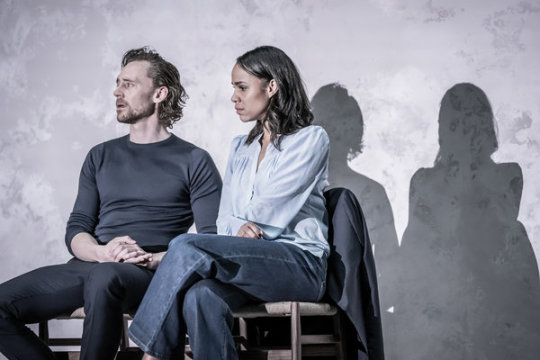
In this country, Mr. Hiddleston is mainly a screen star, known also for playing Jonathan Pine in the John le Carré series “The Night Manager” on AMC. There are plans, too, for him to bring Loki to Disney’s streaming service in a stand-alone series.
But at home in London, he has amassed some impressive Shakespearean credits, including the title roles in Kenneth Branagh’s “Hamlet” and Josie Rourke’s “Coriolanus,” and a turn as Cassio in Michael Grandage’s “Othello” — a production that Pinter, saw some months before he died in 2008. That was the year Mr. Hiddleston won a best newcomer Olivier Award for Cheek by Jowl’s “Cymbeline.”
Jamie Lloyd’s “Betrayal,” which has a staging to match the spareness of Pinter’s language and a roiling well of squelched emotion to feed its comedy, is Mr. Hiddleston’s Broadway debut. Likewise for his co-stars, Zawe Ashton (of Netflix’s “Velvet Buzzsaw”), who plays Emma, Robert’s wife; and Charlie Cox (of Netflix’s “Daredevil”), who plays Emma’s lover, Jerry, Robert’s oldest friend.
Beginning at what appears to be the end of Robert and Emma’s marriage, after her yearslong affair with Jerry has sputtered to a stop, it’s a drama of cascading double-crosses. First staged by Peter Hall in London in 1978 — and in 1980 on Broadway, where it starred Roy Scheider, Blythe Danner and Raul Julia — it rewinds through time to the sozzled evening when Emma and Jerry overstep the line.
The most recent Broadway revival was just six years ago, directed by Mike Nichols and starring Daniel Craig as Robert, Rachel Weisz as Emma and Rafe Spall as Jerry. It might seem too soon for another, let alone one with sexiness to spare — except that Mr. Lloyd’s production is also marked by a palpable hauntedness and a profound sense of loss.
Reviewing the London staging in The New York Times, Matt Wolf called it “a benchmark achievement for everyone involved,” showing the play “in a revealing, even radical, new light.” Michael Billington, in The Guardian, called Mr. Hiddleston’s performance “superb.”
What’s curious is that Mr. Hiddleston, so good at bad boys, isn’t playing Jerry, the more glamorous role: the cad, the pursuer, the best man who goes after the bride. But Mr. Lloyd said that casting him that way was never part of their discussions.
Last fall, when Mr. Lloyd persuaded Mr. Hiddleston to read a scene with Ms. Ashton for a one-night gala celebration of Pinter in London, part of the season-long Pinter at the Pinter series, there was no grand plan. Having asked Mr. Hiddleston about a possible collaboration for years, since “just before he became ridiculously famous,” Mr. Lloyd said, this was the first time he got a yes.
“I just really admired his craft of acting, the precision of his acting, as well as his real emotional depth and his real wit,” Mr. Lloyd said. “And he’s turned into what I think is the epitome of a great Pinter actor. Because if you’re in a Pinter play, you have to dig really deep and connect to terrible loss or excruciating pain, often massive volcanic emotion, and then you have to bottle it all up. You have to suppress it all.”
This, he added, is what Mr. Hiddleston does in “Betrayal,” where characters’ meaning is found between and behind the words, not inside them.
“Some of the pain that he’s created in Robert, it’s just unbearable, and yet he always keeps a lid on it,” Mr. Lloyd said.
The scene Mr. Hiddleston and Ms. Ashton read at the gala appears at the midpoint of “Betrayal”: Robert and Emma on vacation in Venice, at a moment that leaves their marriage with permanent damage. Within days, Mr. Hiddleston told Mr. Lloyd that he was on board for a full production.
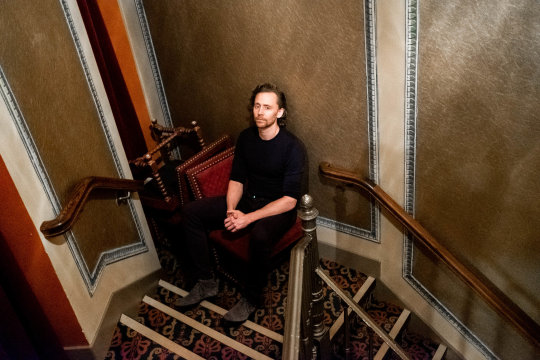
‘What remains private’
Photos taken, back in the faintly more lived-in of his Broadway dressing rooms, Mr. Hiddleston opened the window to let in some Midtown air — and when you’re as tall as he is, 6 feet 2 inches, opening it from the top of the window frame is easy enough to do. Then, making himself an espresso with his countertop machine, he sat down to talk at length.
“I’m always curious about the presentation of a character’s external persona versus the interior,“ he said. “What remains private, hidden, concealed, protected, and what does the character allow to be seen? We all have a very complex internal world, and not all of that is on display in our external reality.”
He can tick off the ways that various characters of his conceal what’s inside: Loki, with all that rage and vulnerability “tucked away”; the ultra-proper spy Jonathan Pine, in “The Night Manager,” “hiding behind his politeness”; Robert, a lonely man wearing “a mask of control” that renders him “confident, powerful, polished,” at least as far as any onlookers can tell.
In “Betrayal,” each of the three principals has an enormous amount to hide from the people who are meant to be their closest intimates. It’s a play about power and manipulation, duplicity and misplaced trust, and what’s so threatening about it is the very ordinariness of its privileged milieu. This snug little world that once seemed so safe and ideal — the happiest of families, the oldest of friends — has long since fallen apart.
But to Mr. Hiddleston, Pinter’s drama contains two themes just as significant as betrayal: isolation and loneliness.
“The sadness in the play — it’s not only sadness; because it’s Pinter, there’s wit and levity as well — but if there is sadness in the play,” he said, “I think it comes from the fact that these betrayals render Robert, Emma and Jerry more alone than they were before.”
Trust and self-protection
One-on-one, Mr. Hiddleston was more cautious than he’d been during the photo shoot, surrounded then by a gaggle of people affiliated with the show. Still, when I asked him about betrayal, lowercase, he went straight to the condition it violates.
“To trust is a profound commitment, and to trust is to make oneself vulnerable,” he said, fidgeting with a red rubber band and choosing his words with care. “It’s such an optimistic act, because you’re putting your faith in the hands of someone or something which you expect to remain constant, even if the circumstances change.”
“I’m disappearing down a rabbit hole here,” he said, “but I think about it a lot. I think about certainty and uncertainty. Trust is a way of managing uncertainty. It’s a way of finding security in saying, ‘Perhaps all of this is uncertain, but I trust you.’ Or, ‘I trust this.’ And there’s a lot of uncertainty in the world at the moment, so it becomes harder to trust, I suppose.”
An interview itself is an act of trust, albeit often a wary one. And there was one stipulated no-go zone in this encounter, a condition mentioned by a publicist only after I’d arrived: No talk of Taylor Swift, with whom Mr. Hiddleston had a brief, intense, headline-generating romance that, post-breakup, she evidently spun into song lyrics.
That was three years ago, and I hadn’t been planning to bring her up; given the context of the play, though, make of that prohibition what you will. Mr. Hiddleston, who once had a tendency to pour his heart out to reporters, knows that he can’t stop you.
“It’s not possible, and nor should it be possible, to control what anyone thinks about you,” he said. “Especially if it’s not based in any, um —” he gave a soft, joyless laugh — “if it’s not based in any reality.”
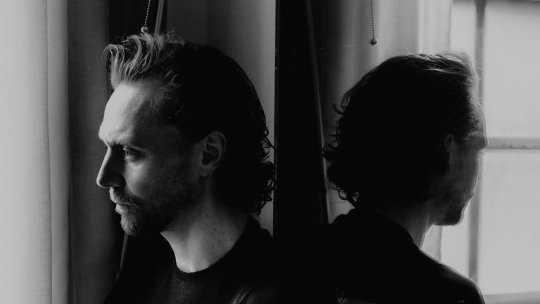
That’s something he’s learned about navigating fame — about being put on a pedestal that’s then kicked out from under him. He knows now “to let go of the energy that comes toward me, be it good or bad,” he said. “Because naturally in the early days I took responsibility for it.”
“And yes, I’m protective about my internal world now in probably a different way,” he added, his tone as restrained as his words. He took a beat, and so much went unsaid in what he said next: “That’s because I didn’t realize it needed protecting before.”
Even so, he doesn’t give the impression of having closed himself off. When something genuinely made him laugh, he smiled a smile that cracked his face wide open.
And the way he treated the people around him at work — with a fundamental respect, regardless of rank, and no whiff of flattery — made him seem sincere about what he called “staying true to the part of myself that’s quite simple, that’s quite ordinary.”
That investment in his ordinariness, as he put it, is a hedge against the destabilizing trappings of fame, but it doubles as a way of protecting his craft.
It’s also of a piece with his insistence that vulnerability is a necessary risk to take, at least sometimes.
“If you go through life without connecting to people,” he asked, “how much could you call that a life?”
#tom hiddleston#betrayal#betrayal broadway#harold pinter#bernard b jacobs theatre#theatre#broadway#jamie lloyd#zawe ashton#charlie cox#the new york times
111 notes
·
View notes
Text
the Smashers and their Host Ch13 Preview
Series: Super Smash Bros.
Characters: Reader, Literally Everyone In Super Smash Bros Ultimate
Summary: You're an inter-dimensional being that owns a huge estate situated on the cusp of spacetime. You've been asked to rent out your mansion for the upcoming Super Smash Bros. tournament. What could possibly go wrong?
Tags: Reader-Insert, Romantic & Platonic Harem, Comedy, Fluff, No Smut
Read the fic here!
[So after a year, I finally finished chapter 11... During my writer’s block, I actually started on what was then going to be chapter 12, but I’ve seen then squeezed another chapter between them in the plans. So, if all goes according to plan, this will be May’s update. Anyways, I feel like posting it so!! It’s not as meaty as the chapter 11 preview - this one is only about 2k words instead of a whopping 13k - but I hope you enjoy regardless!]
You can’t help but stare as the roller coaster above slowly reaches its peak before plummeting downwards, accompanied by a chorus of screams. Just watching the cars zip through loops and corkscrews makes your head spin, and you find yourself grateful that you aren’t on that particular ride. You don’t know if your heart could take it.
The repairs at the mansion finished with accompanying fanfare (well, in your head, at least) and you thought you’d be able to sit back and relax for a bit. Your new life had other plans, of course, and the Smashers were absolutely insatiable, so you had been invited to join them to an amusement park. Honestly, you should have declined - you wanted to! - but…
“Pleaaaaase?” Roy had been the one to ask you to join them, giving you puppy dog eyes as he held the brochure out. The park was in a place called Nimbasa City - recently expanded! grand re-opening! - which you recognized as a place in the Pokemon universe.
“You know you can go without me, right?” you tried, still feeling worn out from all the Social Activities and babysitting you’ve been doing lately. The other day, you found DK using Pac-man as a bowling ball to “prank” anyone wandering the halls. Then the following day, you’re pretty sure Villager and Toon Link had a slingshot competition with the mansions’ windows. And then the day after that, Leaf helped you play detective to find out who was stealing all the speakers throughout the mansion, just to find Diddy Kong using them to create a “gaming set-up fit for a king”.
Why.
Completely oblivious to your weariness, Roy’s expression remained enthusiastic, even when he gave you a mock-frown. “Sure, but, you said we would hang out together next time everyone was doing something!”
“I did?”
“Yeah, you did!”
Oh right, you did. You did say that after he wasn’t invited to the sleepover. Curse you and your desire to keep everyone happy! Now you have to go!
And so, after someone consulted Master Hand about building a temporary transporter directly to Nimbasa City, here you are.
“Whoa, it’s even cooler than in the pictures!” Roy, determined to take you up on your offer to spend time together, arrived via teleporter alongside you. While the mansion has been abuzz over another multiverse outing, you have no idea who actually intended on going. It’s already midday, so there are probably plenty of Smashers already here…
Pulling your gaze away from the roller coaster, you notice that your redheaded companion was also staring intently at the Rayquaza-themed deathtrap. His expression is strained, leading you to believe the both of you are thinking the same thing.
“Why don’t we start with getting something to eat?” you suggest, thinking of the safest option possible. Oh, but if you end up going on rides with a full stomach… Hm, maybe that’s not as safe as you thought. But Roy eagerly takes your suggestion and you have no choice but to follow him to the food court.
“That’s a great idea! I’m dying to see what kind of food this world has!”
You can’t help but agree, but his words have curiosity bubbling within you. “Have you never visited the Pokemon world before?”
“Only once, during Melee!” His grin is almost infectious, though it mellows out as he continues talking. “We never came out here during the last tournament season! ...Or at least, not while I was around.” Roy frowns a moment before putting on another smile, though this one seems a bit more forced. “Melee’s whole thing though was that we were travelling to a new universe for each round of the tournament. For the Pokemon world though, we took a blimp to the stadium, so we didn’t really get to explore…”
That’s right - you forgot Roy was technically only invited to one full tournament, so he wouldn’t have had as much time to relax and travel around with the others. It was only by popular demand that he was invited for the “extra” tournaments, appearing alongside Ryu as a secret opponent for the champions of the mini doubles tournament. They’d both go on to appear in the remaining tournaments and random matchups of the season. While that would have given him a few months to participate in fun activities with the others, you have to imagine a lot of that slows down during tournament season.
“But, a few Smashers and I snuck out between matches to check out the local town.” Roy continues his story sheepishly, smiling fondly at the memory. “And then we uh, went a bit too far… got lost in a cave… We made it back just in time for our next match, but Master Hand really gave us an earful…” He laughs awkwardly, and you find yourself snickering at the idea of Master Hand panicking when he discovered some of his hotshot superstars have gone missing.
“Who all went with you?”
He counts them off on his fingers as he lists everyone. “Me, Pichu, Young Link, Popo, Nana... oh, and Ness. Pikachu ended up being the one who found us lost in the cave.”
You can just imagine the six of them running in circles trying to find the exit, just to have Pikachu show up and use its familiarity of the region to lead them out in mere minutes.
...Huh. Funny, most of those six are Smashers that didn’t get invited back every year afterwards. And you remember there had once been rumours that Ness wasn’t going to be invited back to Brawl…
...Eh, probably just a coincidence. Master Hand wouldn’t exclude someone over an incident like that.
“I’m surprised Pikachu didn’t try to get you even more lost on purpose,” you say offhandedly. Roy’s expression is surprisingly contemplative.
“Nah, Pikachu used to be cool back then. Like, sure he liked to hype up the crowd, but outside of matches he was really chill.” He pauses. “I was surprised to find out he kind of became a jerk. Apparently he’s just been that way since the start of Brawl.”
“Really?” And here you thought the first tournament had been the catalyst to its inflated ego, where the electric rodent had won both the singles and the doubles tournaments that season. Pikachu’s record during Melee was pretty average… maybe something else happened between that and Brawl? An event none of the Smashers would have known about?
Roy shrugs - he’s just in the dark about it as you are - and you notice you’ve arrived at the food court, signalling the end of the conversation. You spot a Pansage, a Panpour, and a Pansear behind a long counter. Pansage takes orders and hands them to the other two monkeys, who then proceed to rush around unnecessarily chaotically to put the order together. This seems like the type of environment where mistakes are easily made, but a lot of people seem to be eating food from here, so apparently they know what they’re doing…?
You end up ordering a Rawst Burger and a lemonade, while Roy gets a corn dog and a soda pop. On your way to finding somewhere to sit, you spot Falco getting his hot dog stolen by the Duck Hunt Dog. You’re glad he’s too far to notice you laughing.
“Look, there’s space at that table!” Your attention is brought back to Roy, who is pointing at a table with only one other person sitting at it. Coincidentally, the spiky blond haired dude there is someone you recognize as part of the Smash crew. Roy takes longer to recognize him - it’s not until you’ve both rounded the table to sit across from the swordsman that he addresses him.
“Oh hey, you’re that guy… uh, Rain, was it?”
When the blond looks up and you see his face, an involuntary snort arises from your throat as you try to hold back laughter.
“It’s Cloud. Cloud Strife.” Apparently they offer facepainting somewhere at the park, because Cloud’s face is covered in ink that resembles a bunny. When combined with his completely serious expression, you have to hide a smile behind your hand as you sit down.
“Right, that’s it. I knew that.” Roy sits next to you, raising an eyebrow at the swordsman across from you two. “What’s on your face?”
“It’s a rabbit.”
“I guess someone is offering facepainting somewhere?” you clarify helpfully, and Roy’s face lights up in recognition.
“Oh! That sounds fun.” He looks to you with enthusiasm. “Hey, what animal do you think I should get? Heh, probably something fierce, like a lion, or--”
“A puppy,” you reply without hesitation, interrupting his own ideas. Roy looked shocked at your suggestion - almost even offended. Whoops.
“A-A puppy? Not like… a bigger dog? A wolf, maybe…?”
“I think a puppy would suit you as well,” Cloud agrees. Roy’s jaw drops as he’s left struggling for an objection, but Cloud moves the conversation before he can say anything. “They also do portraits - look.”
He hands you a large rolled up piece of canvas paper that you’ve been curious about for awhile now before returning to picking at his funnel cake (mm, you gotta get one of those later). Roy leans into your personal space to take a look as you unroll it.
Oh my. That is certainly a caricature.
Roy almost immediately lets out a laugh. “Wo-ow! That would explain your face.”
The canvas blocks your vision so you can’t see Cloud’s face, but you can hear him exhale deeply. Rolling the portrait back up, you place it down on the table.
“I like the style! The art is very clean.” You’ve seen a lot of skill levels in the art found in your mansion, so it’s pretty easy to think outside of “bad” and “good”. Then of course, there’s your own art to consider… yeesh. “I think the artist really captured your character.”
“That’s what I thought,” Cloud responds with a nod, relaxing in the seat. Roy snorts beside you, and you refrain from elbowing him quiet in favour of shooting him a wry look.
“What, you think you could do better?”
Your challenge seems to actually take him off guard, and he fumbles to regain his confidence. “Uh… pfft. Of course. Anyone could do that.” He tries to laugh confidently, but there’s a clear nervous edge to it. Refusing to show him mercy, you play along by feigning amazement.
“Really? Wow, I’d love to see that. Maybe we should have an art show back at the mansion! Wouldn’t that be fun?”
“O-Ooh, I mean… You really think people would be interested in that…?”
Cloud recognizes the game you are playing and chimes in with an immediate “I would”. You do a gesture as if to say “see??”, smiling bright and devious until his resolve finally breaks.
“F-Fine! I’ll do it! But don’t say I didn’t warn you, cuz I’m… really good!!” His voice shakes with anxiety at the end, and it takes all you have not to burst out laughing. This is good. This is so good. You’ll have to file this “art show” idea away for down the road, so you can spring it on him again unexpectedly. Although, torture and humiliation aside, you actually suddenly are curious if any of the Smashers are secretly artists.
“Yes! I’m looking forward to it!” With a grin, you end the conversation by finally picking up your burger and taking a bite into it. Huh, it tastes… fruity. Bitter. Wait, that must be because there are Rawst Berries used in it. Guess you should have seen this coming. You don’t hate it, but the taste has definitely taken you off-guard and you’re not sure you like the mix of meat and berry.
You must have been making a face because Cloud slides his funnel cake plate halfway across the table. “Here. I probably won’t finish it anyways.”
Forgetting about his previous worries, Roy smiles and reaches for the plate. “Ooh, don’t mind if I do--” To his dismay, Cloud hits his hand away.
“I didn’t offer it to you.”
Roy looks torn. You’d feel bad for him if it wasn’t so funny. Likewise, you usually try to politely decline gifts so as to not seem greedy, but you are enjoying having fun at Roy’s expense. “Thanks!” You put down the burger and reach for a piece of the doughy, sugary treat. Ripping it off, you pop it in your mouth and audibly hum in delight. Hehe, you’re a real devil!! If you wanted to be really mean, you could mention how sad it is that Roy can’t know how good this is, but you are not that cruel. Not right now, at least.
Between stealing chunks of funnel cake and continuing to try finishing the burger (nnnnnope, still tastes weird!), you let your mind wander to thoughts regarding the swordsman across from you. Back in the day, Cloud was a popular request to join the tournament despite existing extremely far away from the bubble of universes Master Hand typically picked from. When he was announced as a surprise participant in the final Super Smash Bros. 4 season tournament, fans exploded with excitement. You were honestly surprised to see him on the list for the Ultimate roster - you hear that Cloud Strife is a tough guy to work with and that’s why he doesn’t make many multiverse appearances despite his popularity. Not even the heads of the more local Playstation All-Stars tournament could get him. Master Hand must have really pulled some strings to get him to participate in Smash not once, but twice.
[...and that is unfortunately all I have. See you next month for chapter 12!]
4 notes
·
View notes
Text
Adamare (1/7)
Read here on ao3.
Tags: Harry Potter AU, Friends to Lovers, Bruce Wayne is a good parent, Friendship, Teenagers, Christmas, First Love, Bullying, blood supremacy
Summary: Jason starts magic school two years late and with a terrible reputation. To say that his time there isn’t easy would be an understatement. Some people, however, make everything worth it.
Year One
“Todd, Jason!”
Feeling the stares on him as he walked to the front, Jason reminded himself that his clothing was just as new and shiny as everyone else’s here. Of course, that thought then just made him feel ashamed of himself. He’d been Bruce Wayne’s ward for less than five months; he wouldn’t start taking this money for granted, not now, not ever.
Jason shifted his gait so his sneakers dragged along the ground a bit and his cloak fell open slightly, revealing his favorite hoodie underneath. There. Better.
The room was silent as he sat down on the chair in the front and lifted the hat onto his head as he had seen other students do. It would sort them into houses, which was weird to Jason but supposedly normal for an English boarding school. Apparently, this school was modeled on a major one in Great Britain. The white upper-class wizards that had been among the first to ‘settle’ the East Coast had sniffed their noses at the school founded by an Irishwoman, of all people, and created one that reminded them of home barely two hundred miles away.
It was called Schola Artis Magicae, for God’s sake. These people had not been imaginative.
No. No, I suppose they weren’t.
Oh, great, the hat was talking to him. How did that even work? Was it telepathy or just a shallow whisper into his ears?
A curious mind, huh? Brave, too, though. Hm… Do you have a preference?
Jason had read up on the houses in ‘A History of Magic’ before he came here, but even Alfred hadn’t been able to satisfactorily explain to him what the point was. Dividing children up by allegedly defining characteristics seemed premature to him, not to mention leading to potentially dangerous stereotyping. Why not just go and go by favorite color or something? What was the problem with drawing lots? It was just stupid—
I see. “Ravenclaw!”
Right. That was the blue and bronze table. Jason headed towards under applause that was lukewarm at best. A few students smiled at him, but mostly everyone was occupied with watching the rest of the sorting hat ceremony.
When it was over, the food appeared. At least Jason had read about this, so he was prepared for this. Still, this was… a lot of food. Even Alfred would disapprove of the waste. Who even made all this? Hopefully, it was just a feast for a special occasion…
As he ate, Jason looked around. The Hufflepuff and Gryffindor tables were behind him, so he focused on the Slytherin one (green and silver). He tried to remember what this house’s supposed defining trait was—cunning? Ambition? Something like that? Honestly, most of them just looked like kids to him. One of them was even tinier than all of the other first years. With a pang of pity, he thought: He’s gonna get eaten.
Then, another one of the Slytherins said something, and Jason watched as the tiny first year drew himself up and fixed him with a glare so cold Jason was a bit surprised it wasn’t magical and turned the older student into stone. Jesus, where had the kid learned to do that? Jason clearly didn’t need to worry about him.
Maybe he should worry about himself. None of his fellow first-years had spoken a word to him so far.
After dinner, their prefect took them up to the tower. The riddle system for the portrait seemed easy to crack to Jason, but maybe that was the point? This was a school, for God’s sake. They were shown their rooms, but when Jason made to follow the other boys inside, the prefect took him aside. “Look, we’re aware you’re in a somewhat… unique situation.”
Jason just stared at him, saying nothing.
“And I thought… It just happens that two years ago, only one boy got selected for Ravenclaw. I’ve never been happy about having anyone living alone, so… maybe you’d be more comfortable rooming with someone your own age?”
Great. Another thing that would make him stand out. Jason wanted to decline, saying he’d be just fine rooming with the eleven-year-olds.
However… looking at the group that was supposed to be his, he counted six people. Jason knew himself well enough to know that living with this many kids would drive him up the wall within a week. Rooming with a single person who hopefully had matured a bit might be more manageable.
“Okay.”
The prefect looked relieved. “Great. I already talked to him, he loved the idea. Your dorm is this one, then.”
The staircase shifted enough to let Jason knock on the small, wooden door.
“Come in!” a cheerful voice called.
Jason did. The room was airy and spacious with two four-poster beds and roomy closets, as well as huge floor-to-ceiling windows. A lanky redhead sat on the ground between the beds, a multitude of random items spread around him. The first thing Jason noticed about him was his smile; the second was his hands, incongruously large and calloused for someone who looked like a breeze could topple him over.
“Uh, hi? I’m supposed to be staying here.”
The boy got up in a hurry. “Jason, right? Nice to meet you, dude, I’m Roy.”
“Hey.” Jason gave an awkward little wave.
“You can put your stuff in there. I’ve been sleeping by the wall, is that alright with you?”
“Yeah, that’s fine.” Better than, actually. Closed spaces still made Jason antsy.
While Jason unpacked his things (all the equipment Bruce had bought, some clothes, his favorite books), Roy sat back down on the ground and watched him. “So you’re my age, right?”
“I guess? I’m thirteen.”
“How come you’re only starting now?”
Jason, to his own surprise, appreciated the frank questions. Might as well get it out now. “I was only adopted into a Wizarding family last year.”
“Oh yeah, by the Waynes, right? I know your brother.”
Well, that made one of them. Dick had been very distant when he’d been home during the summer; Jason had gotten the distinct impression that he’d disapproved of Bruce adopting Jason. The fighting had been hard to miss.
“Didn’t you get your letter before that, though?” Roy asked curiously.
Jason shrugged. “Sure. But I had no way to follow up on it.” A kid trying to fend for himself on the streets didn’t have the kind of resource that got him to a magical train station. Not to mention, he wouldn’t have been able to afford a wand, back then.
Trying to lighten the mood, he added: “I also thought it was a prank. Like, if you’re a muggle, giant owls following you to draft you into a magic school means that you’ve either gone mad, your friends are having a laugh, or someone is trying to kidnap you.”
Roy snorted. “Fair. Well, you’re here now. Wanna help me build a glitter bomb?”
Jason took in the equipment surrounding his new roommate. “That’s a lot of stuff for a simple glitter bomb.”
“The plan might just be to have it follow around the DADA teacher. Have it spell out stuff, maybe.”
“Why the DADA teacher?”
“She likes making the first-years cry on their first day.”
Jason thought of the prim blonde sitting at the teacher’s table and plopped down next to Roy. “Can you add sound? I’m thinking ‘Barbie Girl.’”
Roy held out a hand. “Jason, this is the beginning of a beautiful friendship.”
Jason shook it gravely. Maybe this year wouldn’t be so bad.
#jaytim#jaytimbingo2019#adamare#elareine writes#this is marion's fault and she knows what she's done#(thank you)
36 notes
·
View notes
Link
Tom Hiddleston was posing for a portrait, and the face he showed the camera wasn’t entirely his own.
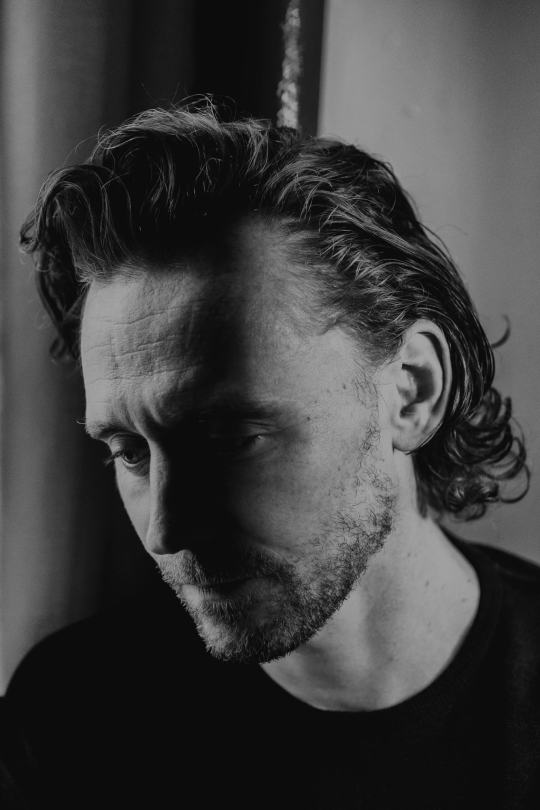
“I’m protective about my internal world now in probably a different way,” says the actor Tom Hiddleston, making his Broadway debut in “Betrayal.”
Credit: Devin Yalkin for The New York Times
That had been his idea, to slip for a few moments into the character he’s playing on Broadway, in Harold Pinter’s “Betrayal”: Robert, the cheated-on husband and backstabbed best friend whose coolly proper facade is the carapace containing a crumbling man. And when Mr. Hiddleston became him, the change was instantaneous: the guarded stillness of his body, the chill reserve in his gray-blue eyes.
“It’s interesting,” Mr. Hiddleston said after a while, analyzing Robert’s expression from the inside. “It gives less away.” A pause, and then his own smile flickered back, its pleasure undisguised. “O.K.,” Mr. Hiddleston announced, himself again, “it’s not Robert anymore.”
It was late on a muggy August morning, one day before the show’s first preview at the Bernard B. Jacobs Theater, and Mr. Hiddleston — the classically trained British actor best known for playing the winsomely chaotic villain Loki, god of mischief and brother of Thor, in the Marvel film franchise — had been in New York for less than a week.

Mr. Hiddleston as Loki in “Thor: Ragnarok.”
Credit: Marvel Studios/Walt Disney Studios Motion Pictures
He’ll be here all autumn for the limited run of the production, a hit in London earlier this year, but he wasn’t going to pretend that he’d settled in. “I literally have never sat in this room before,” he’d said at the top of the photo shoot, in his cramped auxiliary dressing room, next door to the similarly tiny one he had been occupying.
He’d had nothing to do with the space’s camera-ready décor. So there was no use making a metaphor of the handsome clock with its hands stopped at 12 (“Betrayal” is famous for its reverse chronology; far more apt if the clock had run backward), or of the compact stack of pristine books that looked like journals, with pretty covers and presumably empty pages: a bit off-brand for Mr. Hiddleston, who at 38 has a model-perfect exterior with quite a lot inscribed inside.
Take the matter-of-fact way he said, in explaining that he’d first encountered Pinter’s work when he studied for his A-levels in English literature, theater, Latin and Greek: “It was a real tossup between French and Spanish or Latin and Greek. I thought, I can always speak French and Spanish, I can’t always read Latin and Greek, so I’ll study that and I’ll speak the other two.”
From a one-night reading to Broadway

Mr. Hiddleston and Zawe Ashton portray a married couple in Harold Pinter’s “Betrayal”
Credit: Marc Brenner
In this country, Mr. Hiddleston is mainly a screen star, known also for playing Jonathan Pine in the John le Carré series “The Night Manager” on AMC. There are plans, too, for him to bring Loki to Disney’s streaming service in a stand-alone series.
But at home in London, he has amassed some impressive Shakespearean credits, including the title roles in Kenneth Branagh’s “Hamlet” and Josie Rourke’s “Coriolanus,” and a turn as Cassio in Michael Grandage’s “Othello” — a production that Pinter, saw some months before he died in 2008. That was the year Mr. Hiddleston won a best newcomer Olivier Award for Cheek by Jowl’s “Cymbeline.”
Jamie Lloyd’s “Betrayal,” which has a staging to match the spareness of Pinter’s language and a roiling well of squelched emotion to feed its comedy, is Mr. Hiddleston’s Broadway debut. Likewise for his co-stars, Zawe Ashton (of Netflix’s “Velvet Buzzsaw”), who plays Emma, Robert’s wife; and Charlie Cox (of Netflix’s “Daredevil”), who plays Emma’s lover, Jerry, Robert’s oldest friend.
Beginning at what appears to be the end of Robert and Emma’s marriage, after her yearslong affair with Jerry has sputtered to a stop, it’s a drama of cascading double-crosses. First staged by Peter Hall in London in 1978 — and in 1980 on Broadway, where it starred Roy Scheider, Blythe Danner and Raul Julia — it rewinds through time to the sozzled evening when Emma and Jerry overstep the line.
The most recent Broadway revival was just six years ago, directed by Mike Nichols and starring Daniel Craig as Robert, Rachel Weisz as Emma and Rafe Spall as Jerry. It might seem too soon for another, let alone one with sexiness to spare — except that Mr. Lloyd’s production is also marked by a palpable hauntedness and a profound sense of loss.
Reviewing the London staging in The New York Times, Matt Wolf called it “a benchmark achievement for everyone involved,” showing the play “in a revealing, even radical, new light.” Michael Billington, in The Guardian, called Mr. Hiddleston’s performance “superb.”
What’s curious is that Mr. Hiddleston, so good at bad boys, isn’t playing Jerry, the more glamorous role: the cad, the pursuer, the best man who goes after the bride. But Mr. Lloyd said that casting him that way was never part of their discussions.
Last fall, when Mr. Lloyd persuaded Mr. Hiddleston to read a scene with Ms. Ashton for a one-night gala celebration of Pinter in London, part of the season-long Pinter at the Pinter series, there was no grand plan. Having asked Mr. Hiddleston about a possible collaboration for years, since “just before he became ridiculously famous,” Mr. Lloyd said, this was the first time he got a yes.
“I just really admired his craft of acting, the precision of his acting, as well as his real emotional depth and his real wit,” Mr. Lloyd said. “And he’s turned into what I think is the epitome of a great Pinter actor. Because if you’re in a Pinter play, you have to dig really deep and connect to terrible loss or excruciating pain, often massive volcanic emotion, and then you have to bottle it all up. You have to suppress it all.”
This, he added, is what Mr. Hiddleston does in “Betrayal,” where characters’ meaning is found between and behind the words, not inside them.
“Some of the pain that he’s created in Robert, it’s just unbearable, and yet he always keeps a lid on it,” Mr. Lloyd said.
The scene Mr. Hiddleston and Ms. Ashton read at the gala appears at the midpoint of “Betrayal”: Robert and Emma on vacation in Venice, at a moment that leaves their marriage with permanent damage. Within days, Mr. Hiddleston told Mr. Lloyd that he was on board for a full production.

Mr. Hiddleston at the Jacobs Theater, where “Betrayal” opens on Sept 5.
Credit: Devin Yalkin for The New York Times
‘What remains private’
Photos taken, back in the faintly more lived-in of his Broadway dressing rooms, Mr. Hiddleston opened the window to let in some Midtown air — and when you’re as tall as he is, 6 feet 2 inches, opening it from the top of the window frame is easy enough to do. Then, making himself an espresso with his countertop machine, he sat down to talk at length.
“I’m always curious about the presentation of a character’s external persona versus the interior,“ he said. “What remains private, hidden, concealed, protected, and what does the character allow to be seen? We all have a very complex internal world, and not all of that is on display in our external reality.”
He can tick off the ways that various characters of his conceal what’s inside: Loki, with all that rage and vulnerability “tucked away”; the ultra-proper spy Jonathan Pine, in “The Night Manager,” “hiding behind his politeness”; Robert, a lonely man wearing “a mask of control” that renders him “confident, powerful, polished,” at least as far as any onlookers can tell.
In “Betrayal,” each of the three principals has an enormous amount to hide from the people who are meant to be their closest intimates. It’s a play about power and manipulation, duplicity and misplaced trust, and what’s so threatening about it is the very ordinariness of its privileged milieu. This snug little world that once seemed so safe and ideal — the happiest of families, the oldest of friends — has long since fallen apart.
But to Mr. Hiddleston, Pinter’s drama contains two themes just as significant as betrayal: isolation and loneliness.
“The sadness in the play — it’s not only sadness; because it’s Pinter, there’s wit and levity as well — but if there is sadness in the play,” he said, “I think it comes from the fact that these betrayals render Robert, Emma and Jerry more alone than they were before.”
Trust and self-protection
One-on-one, Mr. Hiddleston was more cautious than he’d been during the photo shoot, surrounded then by a gaggle of people affiliated with the show. Still, when I asked him about betrayal, lowercase, he went straight to the condition it violates.
“To trust is a profound commitment, and to trust is to make oneself vulnerable,” he said, fidgeting with a red rubber band and choosing his words with care. “It’s such an optimistic act, because you’re putting your faith in the hands of someone or something which you expect to remain constant, even if the circumstances change.”
“I’m disappearing down a rabbit hole here,” he said, “but I think about it a lot. I think about certainty and uncertainty. Trust is a way of managing uncertainty. It’s a way of finding security in saying, ‘Perhaps all of this is uncertain, but I trust you.’ Or, ‘I trust this.’ And there’s a lot of uncertainty in the world at the moment, so it becomes harder to trust, I suppose.”
An interview itself is an act of trust, albeit often a wary one. And there was one stipulated no-go zone in this encounter, a condition mentioned by a publicist only after I’d arrived: No talk of Taylor Swift, with whom Mr. Hiddleston had a brief, intense, headline-generating romance that, post-breakup, she evidently spun into song lyrics.
That was three years ago, and I hadn’t been planning to bring her up; given the context of the play, though, make of that prohibition what you will. Mr. Hiddleston, who once had a tendency to pour his heart out to reporters, knows that he can’t stop you.
“It’s not possible, and nor should it be possible, to control what anyone thinks about you,” he said. “Especially if it’s not based in any, um —” he gave a soft, joyless laugh — “if it’s not based in any reality.”

The actor’s Shakspearean roles include“Hamlet” and “Coriolanus.”
Credit: Devin Yalkin for The New York Times
That’s something he’s learned about navigating fame — about being put on a pedestal that’s then kicked out from under him. He knows now “to let go of the energy that comes toward me, be it good or bad,” he said. “Because naturally in the early days I took responsibility for it.”
“And yes, I’m protective about my internal world now in probably a different way,” he added, his tone as restrained as his words. He took a beat, and so much went unsaid in what he said next: “That’s because I didn’t realize it needed protecting before.”
Even so, he doesn’t give the impression of having closed himself off. When something genuinely made him laugh, he smiled a smile that cracked his face wide open.
And the way he treated the people around him at work — with a fundamental respect, regardless of rank, and no whiff of flattery — made him seem sincere about what he called “staying true to the part of myself that’s quite simple, that’s quite ordinary.”
That investment in his ordinariness, as he put it, is a hedge against the destabilizing trappings of fame, but it doubles as a way of protecting his craft.
It’s also of a piece with his insistence that vulnerability is a necessary risk to take, at least sometimes.
“If you go through life without connecting to people,” he asked, “how much could you call that a life?”
1 note
·
View note
Photo
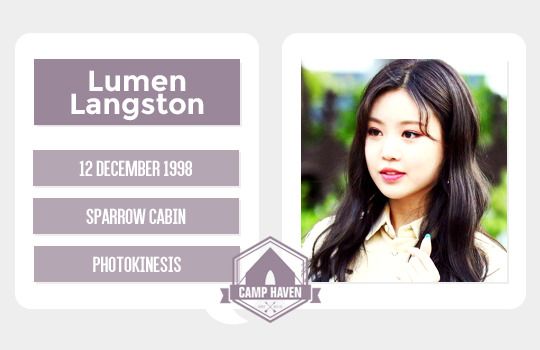
Welcome to Camp Haven, LUMEN LANGSTON!
CAMPER INFORMATION:
Age: 19
Date of Birth: 12 December 1998
Mutation: Photokinesis
Cabin: Sparrow
MUTATION INFORMATION:
(Light Generation) - User can generate light of various intensities.
(Light Absorbtion) - The power to absorb light and utilize them in some way.
(Light Manipulation) - The power to manipulate light.
Lumen has the ability to produce light and remove light from her surroundings. She has also been known possess the ability to bend light and therefore create temporary illusions, however this ability has proven to be much more rare and difficult for her to control.
She can only manipulate light sources that are in her vescinity or nearby and depending on the dificulty of what she is trying to accomplish, she may be left feeling extremely tired or weak. When Lumen experiences high stress situations duress, her body may emmit light in a glowing fashion. This proves that Lumen’s abilities can be affected by her emotional state and can pose occasional difficulties with controling them.
ICEBREAKERS:
1. What color are you? How does this color make you feel?
“Hmmm. Well, I think that depends. I think my mother would say I’m the color yellow like the sun and stars; bright, warm, and comforting. But I never really saw myself the way she did, I always thought I was kind of plain in ordinary like a dull blue. Now that I’m older, I think maybe I could at least meet her halfway and say a soft pastel yellow maybe? Not overpowering or hard on the eyes, but still unique in my own way with a comforting glow.”
2. Sunrise, daylight, twilight, or night? Why?
“Oh wow, that’s a good question. I always loved the sight of a nice sunset, I think everyone probably does… but I think if I’m honest, I’d have to say night time. The moment when that powerful sunset has reached its end and the sky transforms into a sea of deep navy, speckled with hundreds of stars burning billions of miles from us.. it can make you feel so small and insignifigant being met with the realization of how grande the universe is, but at the same time, it’s kind of comforting knowing that there’s so much more happening around you. Ahh… I’ve gone and started rambling again haven’t I?”
3. What quote do you think best describes your life?
“A quote that best describes my life? Hmm, that’s a bit difficult… I think maybe it would be “Learn to light a candle in the darkest moments of someone’s life. Be the light that helps others see; it is what gives life its deepest significance.” - Roy T. Bennett
4. Describe your favorite material object that you already own.
"I think that’s pretty easy actually… I always kind of knew that I was different from everyone else and I always had a feeling that I was adopted, but it wasn’t ever really something that I thought about negatively. I knew my birth parents couldn’t provide for me like they wanted to and I was lucky enough to be adopted by two amazingly loving parents– I know I’m rambling again but I swear I’m getting to a point! When I turned thirteen, my parents gave me this beautiful locket.” Her delicate digits ran over the golden oval-shaped pendant that hung around her neck. “They designed it special for me and inside–” Lumen carefully opened the pendant, showing two small portraits side by side. “On the left is my birth parents and on the right are my adopted parents.” The Langstons might not be my biological parents, but they are my parents and they never let me forget where I came from and who I was… I don’t remember my birth parents, but I know they loved me just as much as my adopted parents and that means the world to me.“
5. If you were stranded on a desert island, what three items would you want to have with you?
"If I were trapped on a desert island…? I’m not sure if I should give the most logical answer or answer with the items I find most important to me. Um… I suppose one of those nifty magnesium firestarters would be a good idea! Maybe one of those handy dandy SAT phones to call for help– I’d want to get back home as soon as possible! And maybe um.. a weapon or something for protection?”
6. What is the most embarrassing thing that’s happened to you that you’re willing to share?
“Most embarrassing thing? Oof, that’s a tough one– I suppose it would have to be from my early childhood. It’s not actually embarrassing really and I don’t actually remember it myself, but my parents have told me that back when I was a toddler, whenever I got really upset or frustrated, I’d cause all the lights in the house to go out. Haha, scared the heck outta them the first few times it happened.”
2 notes
·
View notes
Text
An interview with Alan Power
Alan, you’re a kind of mystery. We don’t know anything about your story. Would you like to tell me something about yourself, your experience in the world of music and your beginnings?
I like the idea of being a mystery but I can’t claim that was my intention. Because I self-release my music I’m just not very well known. I don’t have much of a story. Nothing special anyway. I grew up in London, I went to art school, I was into music so that’s what I decided to do. I was in a band for a while and we had some minor success but then I had kids young and life took over. I was lucky because when I was 16/17 years old a new wave of guitar music was emerging in the UK. Bands like The Libertines and The Strokes gave birth to a new generation of wannabes and I was one of them. A lot of London based bands came out of that time: The Horrors, Larrikin Love, The Video Nasties and The Arctic Monkeys were among the first bands I saw that totally blew my mind. Ten years later and I’m finally getting my act together. But it makes sense now, I was never going to be in an indie band. I needed to live a little more before I could fully express myself.
I think you’re a complete artist, in every single way, like David Bowie or Marc Bolan was. You don’t stop at the music and the lyrics; you have built a very strong identity in your character. On your website I read a quote by Alexa Chung: “It’s like if Johnny Rotten meets Roy Orbison”. I think this description fits you perfectly. What do you think about this?
Thank you. I’ll take that gladly. I think I know what she means.
I listened to your album, Greatest Hits Vol.1, thousand and thousand times and it seemed to be a real declaration of love for the folk and country music. Your music is a continuous quote from the past but at the same time, it sounds like something totally new. How much do old records affect your work?
Ninety per cent of the music I listen to is older music. I just like the way it sounds. I guess it is, in part, a declaration of my love for the culture. This music moves me very much and I am very grateful for that. People like John Prine, Townes Van Zandt, Bruce Springsteen, Gram Parsons and many many more have profoundly deepened my emotional pool. It is timeless. I try to emulate that in my work, for sure.
What’s your favorite old record?
I have no idea to be honest. If I had to say, maybe Tunnel Of Love [Bruce Springsteen] because it reminds me of driving with my wife and kids.
What are your music idols? And what about art, films and books?
I’m a simple man. I’m not particularly cultured like many of my contemporaries. I couldn’t answer this question without it sounding forced, because it would be. I just write songs and they come out how they come out. There’s not much of a process. I don’t get much time to read and watch movies. I have three young kids and a vegetable patch so that keeps me busy when I’m not writing or away recording or playing live.
The first time I saw a picture of you on the internet, I immediately thought of Richard Prince’s series of photos with the Marlboro’s cowboys. If for Richard Prince re-photograph the cowboys of the advertisements wanted to be a sort of criticism of the American ideal, for you it seems to be a celebration of the American style. Dressing like a cowboy defines your character, but you live in the Somerset. Where does your passion for cowboys come from?
I am infatuated with all things American. My grandfather on my mother’s side lived in Florida, and when I was a kid, we went over to see him. It wasn’t the New York or LA experience most people get when they go over there. It was something else. Anyway - that’s a whole story in itself, but I loved it. It was tacky, over the top, bigger, better and more beautiful than anything I’d ever seen. I came back to the UK aged 8/9 and I’ve been American ever since.
The figure of the cowboy is always associated with the freedom and the power of maleness but the cowboy you play is deeply nostalgic and romantic, sometimes even decadent. It’s really amazing this opposition.
This cowboy is from the UK. Which is a totally ridiculous notion in itself. But it allows me to play on the cliché in a way that maybe someone from Texas wouldn’t get away with. It gives me a license to be playful. I often catch myself in the mirror at a show and laugh at the absurdity of it all. Which, for me, is a good headspace to be in. The moment I start taking all of this too seriously is the moment the magic disappears.
Where did you find that beautiful white hat?
I have a few now. One of them I got in a store called Ogg’s Hogan in Preston, Arizona. The rest are just cheap knock offs from online stores.
Your lyrics paint your self-portrait, they reflect perfectly your style. But there’s also a lot of humor in them. It’s like you move down -in a positive sense- the original style of the country music’s lyrics, creating something funny, making them Pop. Prodigal Son is an example. Do you really feel like “A shark in a goldfish bowl”? What does it mean?
“If you want to tell people the truth, make them laugh, otherwise they’ll kill you.” Oscar Wilde.
There is an expression in English, a big fish in a small pond. Which is perhaps a roll I have, at times, played.
Unfortunately, I’ve never seen your live shows. How would you describe your gigs?
I probably wouldn’t. I am very temperamental on stage. If the magic decides to join me I love it, but if the energy isn’t there and I’m not feeling the room I’m not very good at bringing it back to life. It’s something I’m working on.
Why did you decide to answer my questions?
You seem like a nice person and I enjoyed your questions. I liked the aesthetic of your Instagram page and I reserve a deep love for Italy and the people of Italy, I lived in Milan for two years when I was a student. I hope you’re all doing ok during these uncertain times. I saw Andrea Bocelli singing on the Piazza del Duomo in Milan yesterday and I cried and cried.



0 notes
Text
Written Rationale Draft
Written Rationale
This project was about creating a satirical magazine posing as a manifesto for an abhorrent populist party of the type that is currently enjoying a resurgence. The far right went too far decades ago when Timothy Mcveigh detonated his car bomb in Oklahoma City, killing 168 people. It went too far when Dylann Roof killed 9 African Americans in their home church while they held bible study. Too far in New Zealand, too far in Charlottesville and too far in Norway. It went too far when Thomas Mair murdered MP Jo Cox as she held her constituency surgery.
Aside from the 2008 crash, I trace this turn to radicalism to a particular set of people – Alex Jones of Info Wars, Steve Bannon, ‘Tommy Robinson’, Richard Spencer, Rebel Media, Lauren Southern and Milo Yiannopoulos (to name a few). Then there are the ‘reasonable’ people who enable them: Ben Shapiro, Dave Rubin, Fox News, Nigel Farage & Ukip etc. My publication attempts to mock these people.
It seeks to send a strong message by highlighting common racist dog-whistles, hidden agendas and prejudices via the use of fashion and humour. I have tried to address these issues using collaging, styling and photography.
Each model plays a character – Roy Swett as party leader, Chastity Hollers for health, Ambrose Brown for industry, Webb Foote for immigration, Monty Blackshirt for housing, and Dirk Paul for education.
My publication captures each character looking shifty, or otherwise creepy. Getting the balance between a comedic picture and a satirical-but-still-stylised was very important to every shoot. I think this line could have perhaps been better tread in the headshot shoot – where even though lots of effort was put into styling selections – it could have been perhaps elevated to the level of fashion more effectively. Having said this, as images I do think they are very effective and have the satirical effect that I really wanted.
The collages (which are my favourite method of illustration and feature throughout my body of work) were produced from the mindset of some of my politicians. They attempt to complement their imagery and polices, and visually make manifest their words.
I think the world is getting scarier, with ‘men of the people’ either being scripted to the absolute hilt, informed by the latest (illegally?) attained public data or saying abhorrent things that have poisoned the discourse. ‘Telling it like it is’ mostly now seems to mean identifying scapegoats, attacking them and standing up for the ‘traditional working class’ (a dogwhistle for *white* working class), all with either a pint or a golf club in hand. Because this ‘honesty’ is poisonous and negative rather than constructive, I think it is important to not meet this with further negativity. This is often the reaction of well meaning people, but it creates tribes. Further, compassion is so important and I think in some respects necessary here. But validation of this movement is incredibly dangerous. This is why I have, therefore, decided to meet it with humour. To make these powerful figures look less powerful. I focused on distinct tropes, and each shoot was a response to these: ‘conservative women are the most beautiful’, climate change denial, a strong popular leader, pulling yourself up by the bootstraps and paranoid health concerns.
This is a publication for people who despair at our current political climate – people like me. Although this could be seen as ‘preaching to the choir’, I think it is important for people who want to fight the far right to feel empowered – less alone. This, in turn empowers the movement. And a movement, to be truly pervasive, should ideally come from all spheres. Maybe fashion is not the first thing you would think of, but fashion should be motivated by contemporary issues. And for me, this is the greatest, along with climate change. I feel like if you feel a gap for something, if you feel like the way you feel is not being represented, then there are at least a few people who feel the same, and as this is a global movement, and the zine does not focus heavily on one particular nation, it could appeal throughout the western world. The words from this publication are a new idea for me – normally I would include poetry and interviews – but in this circumstance, they come directly from the politicians themselves. To get a real feel for how these people think, I pored over Infowars.com, Alex Jones clips on YouTube, Dave Rubin gaffes (he genuinely wants to scrap building codes because he believes the market would ensure safe builds – NOT SURE THAT WORKS ANYWHERE IN THE WORLD…), Katie Hopkins, Sargon of Akkad, Stephen Yaxley Lennon, Breitbart and Dennis Prager etc. Among other things, I begun to realise just how depressing this worldview is. I lost a lot of hope and humour while submerging myself into this world, and can only imagine what it would be like to believe every word. I think it would make you very, very angry at the world.
I can see this publication on the shelves flanked perhaps by Adbusters and Eye on Design’s latest issue. The are both motivated by external political stimuli, which they respond to in an urgent, but lighthearted way. With more of a focus on fashion, rather than art (although I produced a lot of collages), I think this justifies the gap being left between them on the shelf for The Sovereign Advancement League. The target audience is the same – creative, liberal individuals who are politically motivated – from around 17-40. My unique selling point is the concept as it pairs with fashion. As hard as I looked, I couldn’t find anything similar, but really feel there is a need for it.
This zine will be sold over the internet (find at ellieedis.com/sovereign-advancement-league) at £20 (each costs £10 to print). I would like to make this a series of issues – either continuing with the same group of fake politicians, or with a different group each time focusing on the most pertinent issue of the day – perhaps a whole issue of climate-change-denial. It will be in print each time because, while I think online is a great space to promote, I think it is more likely that people will come across the issue by chance, and feel more of a connection with it in person.
I took all images myself apart from the headshot shoot and the picture that I feature in. The first was shot by Declan Creffield, an amazing professional portrait photo who I was able to collaborate with because I offered to model for him for free. He was great to work with and he really understood the kind of awkward feel I wanted. The second mentioned was a collaboration shoot between me, Lauren Davey (an illustration student) and Simi Kanda (a photography student). We got together to take some fairly simple shots (alternating photography/creative direction ideas) and then went on to edit them however we wanted. Lauren did all of the makeup, and I did the styling. As with most of my work, each shoot was very different from the other, but with a common thread. I like to do this because it keeps it interesting as you go through the zine. I kept the colour scheme (deep red, blue and cream/gold) throughout, to maintain cohesiveness. A lot of these shoots are innovative mainly through post-production, editing faces slightly to carry a sense of evil/awkwardness, changing colours or adding a sense of retro kitsch fantasy by changing the background altogether, as in the final collaboration shoot.
The stylisation of the shoots references a lot of 70s/80s, but the zine is hopefully self-aware enough to modernise these concepts. Further to that, these eras are back in a big way, evidenced by the famous Balenciaga A/W18 campaign shot by Robbie Ausberger. I mainly used lightroom and photoshop to achieve the effects I did.
When it comes to evaluation, as always happens with projects, there were a lot of hurdles to overcome, particularly the headshot shoot, where it was vital that I had at least 7 models showed up on the same day, at the same time. Three models I had planned all messaged last minute to say they couldn’t make it, so sourcing three people who were right for the shoot on the same day it was happening was stressful. Despite this, I actually think that it turned out for the best, and that the models who were able to do it in the end were actually even better for the party. This is the kind of thing you expect when you are asking people for favours, and you have to account for it. I do normally have shoots with two models and shoot them both, so that if one pulls out I can definitely shoot that day, but having backups for 7 people was a lot! I also got my publication printed too early, and noticed certain issues and so had to rejig it and print again. This was tough on finances, but was important to the final outcome. I have learned to be more persuasive and to double and triple check things before I send them off for print.
I am happy and proud of what I produced. I think if I were to do the project again, I might perhaps somehow focus more on the fashion element. I styled everything down to small details, but I think the images could look slightly more editorial (in a fashion communication context). I also produced a short promotional film (also viewable at ellieedis.com/sovereign-advancement-league). I am proud that I managed to turn a political issue I care about deeply into a fully realised, stylised project. The photographer I collaborated with is the most professional I have thus far, and I believe the models are also more relevant to my project than they have been in the past. I pushed myself in this module despite a few hurdles, and I hope it shows.
0 notes
Text
My interest in art started as a North Carolina kid fascinated with comic books. I spent much of my early teens trying unsuccessfully to emulate the comic artists of the day. But, I wasn’t one of those kids who was drawing and painting from the day I could hold a pencil. I really wasn’t interested at all until I was about 11 or 12.
Eventually, I took art classes in high school and considered art as one option for college and career. Of course, I chose something completely different because who does things the easy way? Within a few years though, even that career path – that of a newspaper writer and photographer – brought me back to art in the early days of computer graphics and desktop publishing.
While I don’t do as much with graphics as I used to, it is still a part of my day job. Earlier this year, I created all the posters for the 2017-18 season for a local little theatre in a combination of traditional and digital techniques.
During those first few years in newspaper, and later in the printing industry, I didn’t completely lose interest in traditional art. But it was more of a way to kill time than anything serious. Around 2004, I decided to get serious again and began exploring acrylics for a while. I found I preferred to use acrylics more like watercolors than oils and realized I was drawn more to the watercolors of other artists rather than other media. So, I tested the waters, so to speak, and haven’t looked back.
I’ve loved cars since I bought my first one in the 1980’s. My fascination with them from an artistic standpoint – mostly the rolling sculpture of Detroit’s golden age in the 1950’s – started with the success of my first car painting in acrylics. Of course, shiny sheet metal, chrome reflections and rough rust are a very different story in watercolor. But once I figured out various techniques to get those textures right, I found it to be a lot of fun, especially rust.
So, I’ve got a lot of car paintings floating around. But, I see too many artists who seem to be one-trick ponies; they only ever paint one subject. Sure, they usually do that one subject very, very well. And, I understand they paint what they get paid to paint. But, I can’t imagine they don’t get bored.
I certainly get bored looking at the same thing over and over on their websites. Instead of falling into that trap, I’ve tried to explore other subjects – landscapes, figures, portraits, and still lifes. I’ve been especially successful with musical instruments, shoes, figures, and horror-related subjects. The last few years I’ve been concentrating on landscapes and portraits.
I’m also trying to get away from photographic realism by studying the recent British Impressionist watercolorists, my favorite being John Yardley. It’s too easy to get bogged down in details that don’t tell the story of the painting in question. And, I see too many paintings in which everything in the image is razor sharp and finely detailed.
Having spent some time as a professional photographer, I’m well aware of the ability of a well-crafted photo to direct the eye with depth of field, leaving unimportant portions of the image out of focus. I’m trying to bring that capability and technique to my paintings, especially my landscapes. It’s part of a technique I’ve taken to calling loose realism.
That’s really just another way of describing what most people are talking about then they use the word “painterly.” In loose realism even main subjects need not be photographic to be convincing. Backgrounds and foregrounds can be loose, wet, and indistinct. One method I use for achieving this, and for forcing myself to see a reference photo more simply, is to use Photoshop or other programs to modify the photo, defocus some areas, obscure details, and often brighten colors.
One of the things that has always fascinated me about watercolor is how the simplest images often can be the most effective. That doesn’t necessarily mean they were simple to create, though some are. It just shows that complexity, unerring detail, and edge-to-edge focus aren’t a requirement for a pleasing and effective painting.
The biggest problem with loosening up is that most people, at least in my area, are more interested in photo-realism, especially when looking for car paintings and commissions. So, I’m walking a tight rope between the looser paintings I want to do and the photo-realism the public wants, i.e. sometimes I too paint what I get paid to paint.
Technically, I’m pretty straight-forward these days. In the past though, I’ve used a couple different, somewhat unusual techniques.
An example of Payne’s Gray underpainting
Early on I used a grisaille-type underpainting that I learned while using acrylics. I don’t see many people using or even talking about this technique with watercolors, but I found it quite effective. To do this I painted what most people would consider a value study with a very thin, watered-down Payne’s Gray. Once I had a good grayscale painting done, I added transparent color washes.
Since Payne’s Gray is a staining color and I kept it very thin, it didn’t lift when I added the later washes. If the underpainting was too heavy, though, it could have lifted and altered successive washes and made a real mess. I suppose any staining color can be used for the underpainting. But, a thin Payne’s Gray is nearly neutral, so the transparent colors laid on top are only affected in value, not color or hue. By the time I completed the painting, only I knew there was an underpainting layer.
An example of charcoal and watercolor
Another technique I had a lot of success with – and also learned while using acrylics – is using charcoal as an “underpainting.” This technique starts by doing a complete, finished charcoal drawing of at least the main subject if not the entire image. I spray one thin coat of workable fixative over the charcoal drawing. It might sound counter-intuitive at first. But, without the fixative, you’d have a mess when you started adding watercolor washes.
Anyway, after I let the fixative gas out at least a couple hours, I painted with watercolor as normal. I had to lay it on a little more heavily. But, with practice and patience, watercolor will soak through the fixative and adhere to the paper.
I haven’t used either of these techniques for a few years. These days I’m just using good old Da Vinci paints (mostly) in a fairly limited palette of ultramarine blue, cobalt blue, phthalo blue, permanent rose quinacridone, a warm and cool red, a warm yellow, yellow ochre, raw umber, burnt Sienna, sepia, sometimes manganese blue, and neutral tint or Payne’s gray. No, I don’t use a cool yellow because over time I found I just didn’t use it. My color mixes just never went that direction. So, now I just don’t bother.
Arches and Canson’s Moulin du Roi 140 lb. in cold-pressed and rough are my favorite papers. In the brush department, I’ve used everything from natural sables and squirrels and faux sables and squirrels to natural/synthetic blends and full synthetics. But, right now I’m really digging the super-cheap Snap! synthetics from Princeton. I’ve always liked a good amount of stiffness and spring. Snaps definitely cover that while also holding a lot of water/pigment.
Over the years, I’ve found that if I really wanted to get better, painting had to become an obsession. When I’m not painting I’m thinking about painting. The best advice I can give to someone just beginning with watercolor or any medium, or just wanting to get better, is to paint. Paint often. Paint every day. Paint something, anything, even if it’s just color swatches. The more you have a brush in your hand the more natural it will feel.
An example of a 5”x7” portrait painted during lunch hour at work
Actually, now that I think about it, color swatches are a great idea. Not only will they help with brush control and water control, you’ll also learn how each color looks and feels with varying amounts of water. I keep one of Da Vinci’s full-pan paint boxes at work and spend a few minutes before work and at lunch every day painting small 5”x7” and 8”x10” figures, portraits and landscapes. It’s great practice; it’s relaxing; and I’ve actually sold several of these paintings.
They aren’t always quick; most take two or three days to complete. But, many of them are good finished paintings, not just sketches.
That also brings up another great aspect of watercolor; you can set up and clean up in a couple minutes making it easy to paint on a moment’s notice. As for me, some days those few minutes at lunch might be the only chance I have to get a brush wet – and that makes all the difference.
Anthony Billings
Instagram
Blog
Facebook
Tumblr
Society6
Doodlewash
#WorldWatercolorGroup - GUEST ARIST: "Fueled By Fascination" by Anthony Billings - #doodlewash My interest in art started as a North Carolina kid fascinated with comic books. I spent much of my early teens trying unsuccessfully to emulate the comic artists of the day.
#WorldWatercolorGroup#doodlewash#featured#illustration#painting#watercolor#watercolor illustration#watercolor techniques#watercolour
0 notes
Text
'I'm surprised that football fanzines have survived'
Image copyright Paul Gilham
The purchase of a fanzine remains part of the match-day routine for many football fans, who value an independent, sideways and often light-hearted take on the state of their beloved clubs. The BBC has asked the editors of five publications that are still in print - despite the competition from online offerings - to choose their favourite covers.
"In some ways I'm surprised that fanzines have survived," says Malcolm Clarke, chair of the Football Supporters Federation.
"You might have thought with the rise of social media and the internet they would have vanished years ago, but they haven't.
"I think it is partly due to in some cases a sense of great loyalty... but also because some have very high-quality writing."
The Gooner - Arsenal
Image copyright The Gooner
Mike Francis admits that he was pretty much goaded into forming The Gooner, one of the country's oldest fanzines.
During a trip to a bookshop on Charing Cross Road, he picked up a Chelsea fanzine for his then boss, a Blues supporter, and was given the reply: "That just proves we are a bigger club."
London rivalry also features in one of Mr Francis' favourite covers.
"Around the time that that cover came out we were on a run where we were beating Spurs every time we played them," he remembers.
"Clearly, as Arsenal fans that was a high point of the season.
"We'd probably beaten them five or six times and that was how that cover came about because we were asking: 'How are Spurs ever going to win a derby?'
"We then thought of the most famous Derby winner, Shergar, and that was how the two came together."
Despite its popularity, Mr Francis admits he still "cringes" at his "amateurish" drawing of a horse in a Tottenham shirt.
Image copyright The Gooner
The fanzine has become more polished in its appearance over the years.
The idea for the cover of Issue 235, which featured manager Arsene Wenger in style of a Roy Lichtenstein portrait, came about during a trip on the London Underground.
"I think I just saw an advert on the Tube for a Roy Lichtenstein exhibition and I just thought that it would make a great style for a cover.
"Darren was always keen to try new things so I suggested it to him and that is what he came up with."
At the height of its popularity, Mr Francis estimates they were selling 7,500 copies of each issue, but that figure has dwindled to about 2,000.
The Gooner will cease publication at the end of this season.
The Square Ball - Leeds United
Image copyright The Square Ball
"Some of the best fanzines have some of the worst owners," says one of The Square Ball's co-editors, Paul O'Dowd.
First published in 1989, the fanzine has covered league titles and Champions League football, but also the lows of administration and relegation to English football's third tier.
Mr O'Dowd, who runs the fanzine with three others, says one of his favourite issues they have produced is the "Kenopoly" edition.
Produced during the 2009-10 season, it was what Mr O'Dowd describes as a "sarcastic and satirical" look at the way then Leeds owner Ken Bates ran the club.
"We were working on it for a couple of months... it just seemed to sum up Ken Bates," he says.
"He would use everybody else's money for whatever business he was doing.
"It was just our way of being sarcastic and having a go at Ken Bates in a very artistic way."
Image copyright The Square Ball
Mr O'Dowd says another of his favourite covers was the "Hoof" edition from 2012-13, mocking the "horrible" style of football played during Neil Warnock's tenure.
He says that when the editorial team saw the photo of Michael Brown, it perfectly encapsulated the topic that they wanted to cover.
The headline, written in the style of an Oxford English Dictionary entry, helped to get their simple message across, Mr O'Dowd says.
He explains: "It was to the point, very matter of fact.
"It just summed up the football at the time that was just horrible, and we were paying top dollar to watch it which was the annoying thing."
United We Stand - Manchester United
Image copyright United We Stand
United We Stand has been following the fortunes of Manchester United since the fanzine was a created by a 15-year-old Andy Mitten in 1989.
He says its focus on original content has kept it popular through 275 editions.
One of the publication's early editions gained notoriety, when it wrongly called the outcome of the 1991-92 First Division title race, the last campaign before the introduction the following season of the Premier League.
United We Stand's headline read: "Champions at Last," a nod to the fact that they had not been champions for 25 years.
But the Red Devils then lost three games in a row to hand the title to arch-rivals Leeds.
Image copyright Getty Images
"I'd had 4,000 copies printed and I was stood outside Old Trafford making an absolute fool out of myself," Mr Mitten remembers.
"I was getting loads of abuse because of it, and quite rightly so."
Perhaps luckily for Mr Mitten, a recent house move means he can no longer locate that particular cover, but its notoriety endures.
He is more fond of the June 2017 edition, a tribute to Wayne Rooney before the club's record goal-scorer left to rejoin Everton.
"At the time, most United fans online saw him as persona non grata," he says.
" was our way of saying... he has clearly dipped as a player but he has been a fantastic player here.
"We've put him all of these different shirts because Manchester United change their shirt every five minutes, because they are a commercial beast like every football club.
"But there was nothing commercial about that goal - it was just pure beauty."
Blowing Bubbles Monthly - West Ham United
Image copyright David Blakemore
Blowing Bubbles Monthly is the brainchild of David Blakemore and has been entertaining West Ham fans since 2012.
The fanzine was initially going to be online only, but a test print run proved so popular it is now produced monthly.
Its editor, David Blakemore, says their September 2016 edition (pictured above) is one of his favourites.
"In a season full of highs and lows... it just captured one of the brighter moments, that first goal at the London Stadium," he says.
"We also had an interview with David Gold in there which set the tone for the rest of the season.
"We just felt page after page it was one of our stronger issues."
Image copyright David Blakemore
The September 2017 issue is one Mr Blakemore says feels significant because they "stuck their neck out" and questioned then manager Slaven Bilic's position.
He says the decision was not taken lightly.
"I think most knew that Bilic was on the brink at that time," Mr Blakemore adds.
"That vocal minority who were calling for his head had gathered momentum and by September it was starting to go full power."
Given that the Croatian would be sacked just a few weeks later, it appears Blowing Bubbles, picked their moment perfectly.
Bandy & Shinty - Nottingham Forest
Image copyright Bandy & Shinty
The team in charge of the unusually named Bandy & Shinty, a relatively new Nottingham Forest fanzine, freely admit they are not "traditional fanzine sellers".
Born out of a meeting at a pub to celebrate the club's 150th anniversary, the four-man team behind the publication tend to send out their fanzine via post.
The appeal? The chance to still enjoy match-days with family.
The fanzine's name is a nod to the two hockey clubs that met to form Nottingham Forest in 1865.
History also is an important part of each issue's cover.
"The Brian Clough one (pictured) was extremely popular," says Sean Hockett, one of the team behind Bandy & Shinty.
"I like the fact that a fair number of Forest fans will just be able to identify that image.
"It is based on a photograph when he is sort of laissez-faire.
"He has got his thumb to his nose and he is almost irreverent about the fact he is having his photograph taken.
"It just encapsulates Brian Clough as a character."
Image copyright Bandy & Shinty
Mr Hockett says issue six is also a personal favourite, because it features their most detailed piece of cover art.
"It has taken us out of that zone of just using a silhouetted image," he adds.
"I like the fact you have got the image of John Robertson in the middle of the passport instead of the Queen.
"As a piece of art I just think it's lovely."
Source link
http://www.manutdnews.online/?p=10901
0 notes
Text
There’s Still Time to Visit ‘Catalyst,’ the ACC Graphic Design Portfolio Show
Artists. They pour their hearts and souls into their craft, spending hours perfecting details most wouldn’t even notice. They use their medium to translate and personify complex emotions and concepts, so that average-joes like us simply have to examine and interpret. But in many ways, designers have it even harder. Steve Jobs once said, “design is not just how it looks and feels, but how it works.”
Last week was the opening reception for Multimedia, Graphic Design & Illustration Student Showcase in the graphic design portfolio at ACC. During the evening of April 27th, these talented student-designers presented their final portfolios and reflected on their experiences.
Students in Capstone, or MGD 289 –the final class prospective graphic designers take–rushed to get their final portfolios ready. They each had a small collection posted on the walls and a computer-display cycling through more pieces; many displayed their personally designed resumes or business cards. A sense of relief and satisfaction could be felt in each of them, despite the stress of getting ready for such an important showcase.
After everyone got settled and had a chance to peruse the artwork, Multimedia, Graphic Design & Illustration department faculty members John Hall and Tom DeMoulin took the podium and praised the students for their hard work. Awards were given to various artists, then each Capstone student had a chance to talk about their experiences and share their favorite pieces.
First up was Alyssa Quispe, who won the ‘Best of Show’ award. Quispe created a beautiful design for Harvest House, emphasizing fresh colors and grains to match the restaurant’s products: food and beer. Dean Sanders, a South-Africa native, discussed his growth as a designer. Following them was Tatiana Barela, who produced the fliers for ‘Catalyst’; she found her creative drive when she began working on designs that would appeal to women.
Natalia Lebsack was admired for the illustration of her dog. She experimented with a design style called low-poly to create it, but added detail to make it her own. Next up was Linda Wheeler, who was beaming with professionalism; she created a book cover for an eager client. Amy Roy chose to review her work on some unique Bob Dylan tee-shirts; she was happy she had the freedom to pick the idea. Darren Kirsche followed, a designer proud of his emphasis on brand identity and work with a company’s icons.
Kirsche commended his fellow artists: graphics and design, “See[ing] the progression that all of us have had is really cool.”
Marcelo Cazon gave an inspiring speech, discussing his two-year-old daughter and his inspiration for his poster design for the Denver Zoo. Kathryn Powers also completed designs for the Zoo, working to elevate their logo and much more. Last to speak was Alyssa Carter, who started in fine arts. Through design she was able to build a brand—logos, business cards, etc.—for a new business just starting out.
After each designer spoke, everyone was once again free to roam the gallery and examine the breathtaking designs.
The work of these ten students is the focus of the show, but believe it or not, there’s even more to see. Opposite the Capstone displays, a portion of the gallery is devoted to the work of both concurrent enrollment and traditional students. These artists had to enter their work for a chance to be displayed, so some quality pieces really stood out.
One student, Megan Anderson, created a beautiful portrait that looks more like a photograph than an illustration professional graphic designer. At first glance, it would appear that the hyper-realistic piece was an edited photo. But surprisingly, only Adobe Illustrator, a program for building compositions from scratch, was used to produce it.
There’s still time to come and see all the artwork for yourself. The Colorado Gallery of the Arts is open Monday through Friday from 8am to 7pm and is located on the first floor of the annex building, room A1300. ‘Catalyst’ will be on display through May 8th.
In these last few days of school, come to the gallery and support these talented designers. It might be just the kind of study-break you need. http://www.futureweblinks.com
0 notes